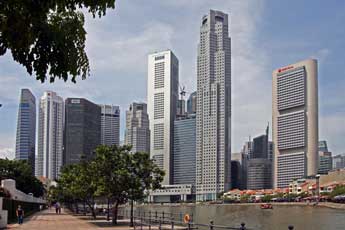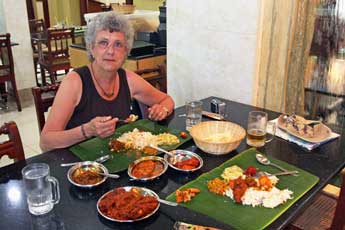 FAR
EASTERN BACK-PACKING VENTURE 2011 - Singapore stop-over: FAR
EASTERN BACK-PACKING VENTURE 2011 - Singapore stop-over:
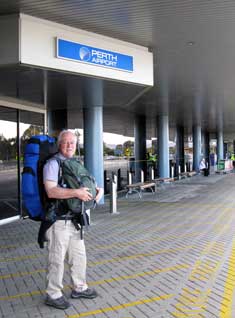 Final morning in Perth:
our final day in Australia, and we were up early to complete packing our kit
ready for today's onward flight to Singapore. We had arranged for the Perth hostel warden
to drive us out to the distant and inaccessible Perth International Airport, for
what seemed an expensive $30; but the journey by bus, the only alternative with all
its uncertainties of timing, would have cost almost as much. We settled
up at the hostel and retrieved our $20 key deposit, and on the drive out to the
airport, it came out in conversation with the warden that he and his wife came originally
from Athens. We did not pursue the detail of how they finished up running a
back-packing hostel in Perth; that seemed a story too far. Saturday morning traffic on was light, and we were dropped at the airport forecourt at 9-15am
(Photo 1 - Perth Airport)
(see left). After
photos, we queued to check-in and to hand in our packs,
along with a large group of what we took to be young Singaporean service-men. Final morning in Perth:
our final day in Australia, and we were up early to complete packing our kit
ready for today's onward flight to Singapore. We had arranged for the Perth hostel warden
to drive us out to the distant and inaccessible Perth International Airport, for
what seemed an expensive $30; but the journey by bus, the only alternative with all
its uncertainties of timing, would have cost almost as much. We settled
up at the hostel and retrieved our $20 key deposit, and on the drive out to the
airport, it came out in conversation with the warden that he and his wife came originally
from Athens. We did not pursue the detail of how they finished up running a
back-packing hostel in Perth; that seemed a story too far. Saturday morning traffic on was light, and we were dropped at the airport forecourt at 9-15am
(Photo 1 - Perth Airport)
(see left). After
photos, we queued to check-in and to hand in our packs,
along with a large group of what we took to be young Singaporean service-men.
Perth International Airport and farewell to Australia:
relieved of our weighty packs, we went up to the departure lounge and counted out our residual
Australian coinage: we had $8.60 left in change, which bought us cups of
coffee, still leaving us $1.20. The only thing in Perth that this would buy was
a pack of chewing gum, so the $1.20 went later into Qantas' charity bag. We
still had $70 in Australian bank notes which we should have to change, albeit at
highly disadvantageous rates, back home. At security
screening, we worked our way through the multi-layers of screening and frisking,
and the offensively surly immigration control; finally and officially we were
out of Australia with exit stamps in our passports to prove it. And we were able
to sit and relax for a
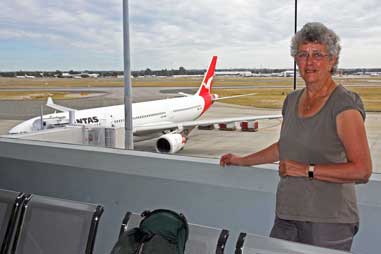 few moments in the lounge area by the gate overlooking
the Qantas Airbus 330 waiting below
(see left) (Photo 2 - Qantas Airbus 330). Our flight departure
was timed for 11-55am, but time passed quickly and we were called to board
at around 11-20. The Airbus 330 was a trim aircraft with a 2‑4-2 seating
arrangement. We therefore had two seats to ourselves on the right hand side
which we had reserved in advance on-line. We took off on time, and as the
aircraft's wheels cleared the runway and the 330 Airbus became airborne, we
finally said farewell to Australia. few moments in the lounge area by the gate overlooking
the Qantas Airbus 330 waiting below
(see left) (Photo 2 - Qantas Airbus 330). Our flight departure
was timed for 11-55am, but time passed quickly and we were called to board
at around 11-20. The Airbus 330 was a trim aircraft with a 2‑4-2 seating
arrangement. We therefore had two seats to ourselves on the right hand side
which we had reserved in advance on-line. We took off on time, and as the
aircraft's wheels cleared the runway and the 330 Airbus became airborne, we
finally said farewell to Australia.
The 5 hour flight passed quickly. We were served a very reasonable lunch from a
menu of Singapore style food, with mini bottles of Australian white wine, and
all during the afternoon the cabin
crew attentively served a series of chilled drinks and fruit . This was without
doubt the most pleasantly civilised of our flights. We
again were able to follow the flight on the route plan, as the plane passed over
Jakarta and unknown places with mysterious oriental names across the Indonesian peninsula.
Geography of Singapore: the small and heavily urbanised city-state
of Singapore covers the diamond-shaped Singapore Island and some 60 smaller
islands, a total land area of 280 square miles, located at the southern tip of
the Malay peninsula, with a population of 5.7 million. To the north, the main island is separated from the Malay
peninsula by the half mile-wide channel of the Johor Strait which is crossed by a
road-rail causeway. The state's southern limits run through the Strait of
Singapore, separating Singapore from Indonesia (see map above right). Located
just 85 miles north of the equator, Singapore's climate is classified as
equatorial with high humidity and abundant tropical rainfall and daytime
temperatures between 25~33°C.
Arrival at Changi Airport Singapore:
as the plane approached Singapore, cloud cover increased and the captain reported heavy
afternoon rain over the city. We landed on time around 5-15pm and, bemused by
the surroundings, followed the crowds along what seemed vast distances of
hallways. We had filled out Singapore immigration cards during the flight and
handed these in at immigration control, receiving another in-stamp on our
passports. Another lengthy trek along to the baggage re-claim and we loaded our
packs onto a trolley. The next section involved lengthy climbs up escalators
and, burdened with our packs, we found the sky-train to take us to the Metro (MRT)
station at terminal 2. Now came the complex issue of buying tickets. Eventually
we figured out the machines and extracted 2 plastic tokens. The fare was $3
each, but it seemed that on completion of the journey, we could retrieve a $1
deposit (for what reason remained one of the mysteries of the East). A Singapore
$ was worth about 50p, so it all seemed remarkably good value.
Metro journey into Singapore:
as we stood bemusedly trying to figure out trains and platforms, a kindly Singaporean
couple took us in hand: we needed to change at the next station, Tanah Merah,
continue on the Green Line several stops to City Hall, and there transfer to the
Red Line for one further stop to Dhoby Ghaut (which sounded more like a sort of
curry). The man bundled us onto the train and spent the journey to Tanah Merah
with us, explaining all the rituals of travel on the Singapore MRT (Mass Rapid
Transit). Thanking him for his thoughtful help, we transferred to our next
train. This was crowded and we had to spend almost the entire journey standing
with our pack, almost dropping with exhaustion; we watched anxiously as unknown station
names sped by. At City Hall, we stumbled across to the final train, and
thankfully emerged at Dhoby Ghaut. Having gratefully been helped yet again by
unknown hands to retrieve our ticket deposits, we emerged from the
air-conditioned station into an enveloping blanket of Singapore's clammy,
tropical humidity.
YMCA Hostel, our accommodation in Singapore:
with the aid of a map print thankfully prepared in advance, we stumbled along Orchard Road amid
evening traffic, gardens of exotic tropical plants, overwhelmingly humid heat,
and the crowds of almost child-like Singapore folk. It was like stepping into a
make-believe fictional world of H G Wells' Time Machine peopled by Eloi; we just
hoped we should not encounter any Morlocks! Unsure of our exact location amid
this urban confusion, Sheila fortunately spotted the YMCA building where our
accommodation had been booked, and we staggered slowly towards it under the weight of our packs
in the tropical heat. We almost fell
into the reception lobby, and the receptionist, a kindly but not overly perceptive
lady, remarked 'You look tired'; it was something of an understatement. Weighed down with our packs,
the stress of the journey, and the Singapore humidity, we were utterly
physically and mentally exhausted. Having checked in, almost comatose with
exhaustion, we took the lift to the 5th floor to find our room.
Falling out of our packs, we collapsed, shirts totally soaking with
sweat from the overwhelming humidity.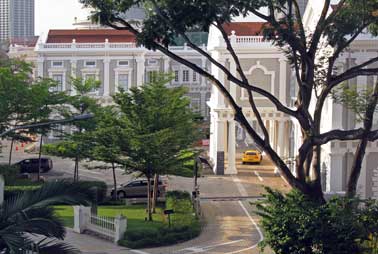
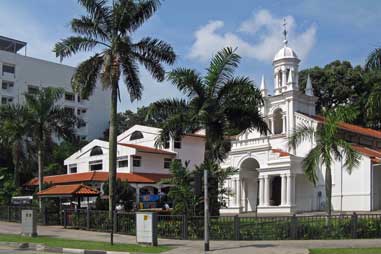 Our first evening in Singapore:
having recovered a little and
cleaned up, we went out to try and find some supper. The receptionist pointed us
in the direction of a food court across the way in the main Bras Basah Road. Our
outline map suggested we should cross an intervening open green space labelled as
Bras Basah Park, but in the meantime some oriental developer had inconveniently filled the open space with a sky-scraper. Weaving our way over, we somehow found the classic Asiatic food hall, and even better next door was an
'Irish pub'. Utterly indifferent to the noise of TVs blaring out an English
football match, we ordered pints of Singapore Tiger beer, and sat obediently
at the bar where the bar girls had escorted us to seats. Revelling in the
refreshing taste
of our beers, we watched in fascination as the barman busily mixed cocktails;
whether they were Irish or not, we did not bother to ask. The beer was expensive, but so welcome after the traumas of our journey in from Changi
Airport. Next door in the food hall, we toured the stalls and ordered bowls of who-knows-what
from a Vietnamese stall. But it tasted delicious, and so hungry
were we that Sheila had a further bowl of oriental ice cream while Paul tucked into a
plate of curry from an Indian stall. Our first evening in Singapore:
having recovered a little and
cleaned up, we went out to try and find some supper. The receptionist pointed us
in the direction of a food court across the way in the main Bras Basah Road. Our
outline map suggested we should cross an intervening open green space labelled as
Bras Basah Park, but in the meantime some oriental developer had inconveniently filled the open space with a sky-scraper. Weaving our way over, we somehow found the classic Asiatic food hall, and even better next door was an
'Irish pub'. Utterly indifferent to the noise of TVs blaring out an English
football match, we ordered pints of Singapore Tiger beer, and sat obediently
at the bar where the bar girls had escorted us to seats. Revelling in the
refreshing taste
of our beers, we watched in fascination as the barman busily mixed cocktails;
whether they were Irish or not, we did not bother to ask. The beer was expensive, but so welcome after the traumas of our journey in from Changi
Airport. Next door in the food hall, we toured the stalls and ordered bowls of who-knows-what
from a Vietnamese stall. But it tasted delicious, and so hungry
were we that Sheila had a further bowl of oriental ice cream while Paul tucked into a
plate of curry from an Indian stall. Returning to the YMCA amid the
crowds of laughing, child-like Singaporean Eloi, we fell into the ultra luxury
of our 'suite'. After the
Returning to the YMCA amid the
crowds of laughing, child-like Singaporean Eloi, we fell into the ultra luxury
of our 'suite'. After the
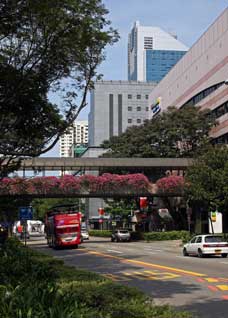 primitive state of the Perth back-packing hostel, such comfort,
albeit at expensive prices, was so welcome. And we slept the sleep of the righteous in this air-conditioned splendour. primitive state of the Perth back-packing hostel, such comfort,
albeit at expensive prices, was so welcome. And we slept the sleep of the righteous in this air-conditioned splendour.
Our first morning in Singapore:
luxurious as our YMCA penthouse suite was, it took the whole time of our stay for we
normally slumming travellers to discover how to make all the features work: the
lights needed our card-key in the slot, the shower tap was disguised as a
pipe-joint, and the air-conditioning was a total mystery which we never did
fathom out! Our room window gave glorious views over nearby grand public
buildings and city skyscrapers
(Photo
3 - View over Singapore) (see above right). This morning, breakfast was another
luxurious indulgence compared with the sparseness of our breakfasts in Perth: a curious intercontinental mélange of dim
sums, baked beans and fried eggs, and we gorged ourselves on such an unaccustomed feast.
We emerged from
the comfortably air-conditioned YMCA building (Photo
4 - Singapore YMCA) into Singapore's over-poweringly humid heat, and set
off along Orchard Road for our first day's city explorations, past a colonial-era English-style
church fronted by palm trees (see above left), and attractive street-gardens of eye-catching, exotic tropical plants which lined the streets
(see right)
(Photo 5 - Street-gardens), along to Dhoby Ghaut MRT station (Photo
6 - Dhoby Ghaut MRT station). One stop along at City Hall, we continued
along North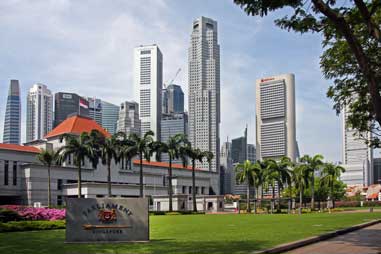 Bridge Road with its English-style red double-decker buses, palm
trees and more street-gardens (see left) (Photo
7 - North Bridge Road), past the iced
wedding-cake-looking St Andrew's Cathedral. This led us along to the Singapore
Parliament Building (see below right) (Photo
8 - Singapore Parliament), and beyond this we reached the northern embankment
of the Singapore River (Photo
9 - North embankment). Here on a sunny morning, the stunningly monumental Central Business District skyline of
the Raffles Place office tower-blocks opened up across the river (Photo
10 - River skyline) (see below left). Along Bridge Road with its English-style red double-decker buses, palm
trees and more street-gardens (see left) (Photo
7 - North Bridge Road), past the iced
wedding-cake-looking St Andrew's Cathedral. This led us along to the Singapore
Parliament Building (see below right) (Photo
8 - Singapore Parliament), and beyond this we reached the northern embankment
of the Singapore River (Photo
9 - North embankment). Here on a sunny morning, the stunningly monumental Central Business District skyline of
the Raffles Place office tower-blocks opened up across the river (Photo
10 - River skyline) (see below left). Along 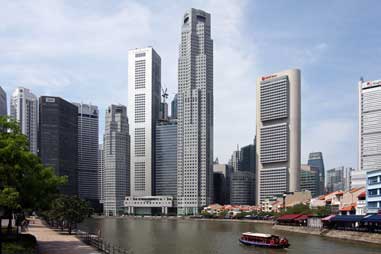 the
far embankment, the brightly painted frontages of former shop-houses and
go-downs
(warehouses), now restored as river-side restaurants, created a contrasting
colourful foreground
(Photo
11 - Riverside shop-houses). One of the most characteristic forms of
traditional architecture in Singapore are the shop-houses, charming rows of
narrow, colourful shop-frontages with dwellings above, and a covered colonnaded
arcade forming a walk-way along the front, both for pedestrians and for
displaying shop wares; these were called five-foot ways.
The shop-house buildings with shop opening onto the pavement served both as
owner's residence and commercial business premises. They have internal
courtyards, open stairwells and sky-lights to bring light and air to otherwise
dark and narrow interiors. Along the river-front, rows of such shop-houses were often accompanied by warehouses
(called go-downs), into which coolies unloaded produce from bum-boats at the
river-quays. The shop-houses of Singapore evolved during the early-19th
century colonial era. The design was first introduced by Stamford
Raffles' the
far embankment, the brightly painted frontages of former shop-houses and
go-downs
(warehouses), now restored as river-side restaurants, created a contrasting
colourful foreground
(Photo
11 - Riverside shop-houses). One of the most characteristic forms of
traditional architecture in Singapore are the shop-houses, charming rows of
narrow, colourful shop-frontages with dwellings above, and a covered colonnaded
arcade forming a walk-way along the front, both for pedestrians and for
displaying shop wares; these were called five-foot ways.
The shop-house buildings with shop opening onto the pavement served both as
owner's residence and commercial business premises. They have internal
courtyards, open stairwells and sky-lights to bring light and air to otherwise
dark and narrow interiors. Along the river-front, rows of such shop-houses were often accompanied by warehouses
(called go-downs), into which coolies unloaded produce from bum-boats at the
river-quays. The shop-houses of Singapore evolved during the early-19th
century colonial era. The design was first introduced by Stamford
Raffles' Town Plan for Singapore to make fullest use of limited land in the new settlement.
Raffles specified the uniformity and regularity of buildings, the materials to be used
as well as features of the buildings such as a covered passageway. Over the
decades after the colonial era, entire blocks of historical shop-houses in the
urban centre were demolished for
high-density, high-rise developments or
governmental facilities. But many of the traditional shop-houses have now been
restored as colourful, tourist-oriented Town Plan for Singapore to make fullest use of limited land in the new settlement.
Raffles specified the uniformity and regularity of buildings, the materials to be used
as well as features of the buildings such as a covered passageway. Over the
decades after the colonial era, entire blocks of historical shop-houses in the
urban centre were demolished for
high-density, high-rise developments or
governmental facilities. But many of the traditional shop-houses have now been
restored as colourful, tourist-oriented  restaurants, particularly along the
river-front quays (Photo
12 - Riverside quays). restaurants, particularly along the
river-front quays (Photo
12 - Riverside quays).
We took a number of photos of Singapore's tower block skyline as we walked along
the embankment (Photo
13 - Tower-block skyline) under the riverside trees; bum boats, now
converted for tourist river-cruises, chugged past (Photo
14 - River bum-boats) along the Singapore River (see left). The river water was now remarkably clean
as a result of recent years' pollution-clearing measures. Before crossing the
bridge to the southern quay of the Singapore River to explore the Chinatown
district, we were first to treat ourselves to a half hour cruise along the river
from Raffles Landing Stage, as an introduction to the fairy-tale Singapore
skyline of sky-scraper office blocks set against the more down-to-earth
foreground of colourful traditional shop-houses along the river-quay (see above
right) (Photo
15 - Singapore river skyline).
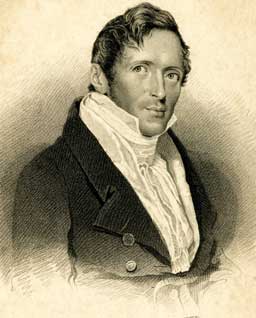 Outline history of Singapore:
between the 16th and 19th centuries, the Malay Archipelago was gradually
colonised by the European powers, beginning with the settlement by the
Portuguese at Malacca in 1509. The early dominance of the Portuguese was
challenged during the 17th century by the Dutch, who controlled
most of the ports in the region and established a monopoly over trade within the
archipelago, particularly in spices, then the region's most important product.
In 1818, British East India Company colonial administrator Sir Stamford Raffles
(see right) was appointed Lieutenant Governor of the colony at Bencoolen on the SW coast of
Sumatra. The Dutch had been stifling British trade in the region by prohibiting
the British from operating in Dutch-controlled ports or by subjecting them to
high tariffs. Determined to increase British power and trading influence in the
Archipelago, Raffles' plan was to challenge the Dutch monopoly by establishing a
new and free trading post along the Straits of Malacca at Singapore Island off the
southern tip of the Malay peninsula. Raffles selected this position as a strategic cross-roads on the trading
routes of SE Asia, with Malay, Indian and Chinese merchants plying the shipping
lanes of the Straits of Malacca at the confluence of the Indian and Pacific
Oceans. He persuaded Lord Hastings, Governor-General of India and his
British East India Company superior, to fund an expedition to establish a new
British trading base in the region. Outline history of Singapore:
between the 16th and 19th centuries, the Malay Archipelago was gradually
colonised by the European powers, beginning with the settlement by the
Portuguese at Malacca in 1509. The early dominance of the Portuguese was
challenged during the 17th century by the Dutch, who controlled
most of the ports in the region and established a monopoly over trade within the
archipelago, particularly in spices, then the region's most important product.
In 1818, British East India Company colonial administrator Sir Stamford Raffles
(see right) was appointed Lieutenant Governor of the colony at Bencoolen on the SW coast of
Sumatra. The Dutch had been stifling British trade in the region by prohibiting
the British from operating in Dutch-controlled ports or by subjecting them to
high tariffs. Determined to increase British power and trading influence in the
Archipelago, Raffles' plan was to challenge the Dutch monopoly by establishing a
new and free trading post along the Straits of Malacca at Singapore Island off the
southern tip of the Malay peninsula. Raffles selected this position as a strategic cross-roads on the trading
routes of SE Asia, with Malay, Indian and Chinese merchants plying the shipping
lanes of the Straits of Malacca at the confluence of the Indian and Pacific
Oceans. He persuaded Lord Hastings, Governor-General of India and his
British East India Company superior, to fund an expedition to establish a new
British trading base in the region.
The name Singapore derives from an
Anglicisation of the native Malay name from the Sanskrit word Singa Pura meaning
Lion City. This originated from the legend of a Sumatran prince who took
shelter from a storm by the island, sighting what he thought was a lion, but more
likely a tiger which were native to Malaysia. Raffles landed on the northern
bank of the Singapore River in 1819, signed a treaty with the Malay Sultan
and nobility to establish a British trading colony here, in competition with the Dutch; amid the
island's mangrove swamps and dense jungle, he oversaw the establishment of the
new trading post. Raffles returned to Bencoolen soon after signing the treaty
and left Major William Farquhar in charge of the new settlement with a small
detachment of Indian troops. Farquhar invited settlers to Singapore, but
was prohibited from collecting port duties to raise revenue as Raffles had
decreed that Singapore should be a free port.
As news of the tariff-free port spread across the archipelago, passing ships were
encouraged to stop in Singapore, and traders flocked to the island seeking to
circumvent Dutch tariffs and trade restrictions. By 1821, the island's
population increased with vastly profitable trade volume.
Raffles returned to Singapore in 1822, highly critical of many
of Farquhar 's policies such as selling licenses for gambling and sale
of opium and tolerance of slave trade;
despite his success in leading the settlement through its difficult early years,
Farquhar was dismissed and Raffles took
over the colony's administration himself. He brought in labourers and merchants from all
over SE Asia, including Chinese, Malay and Indians, building up the settlement
from the native jungle along the Singapore River, and laying out the township
and port. Singapore was organized into functional and ethnic subdivisions
under the Raffles Plan of Singapore, remnants of which can still be seen
in today's ethnic neighbourhoods. A second treaty was signed with the Malay
Sultan and nobility which, in exchange for a nominal yearly payment, extended British
possession to most of the island, bringing it under British Law with the
provision that account would be taken of Malay customs, traditions and religion.
In 1823 Raffles finally left Singapore returning to UK, and in 1824
Singapore was ceded in perpetuity to the East India Company by the Sultan. During its early years Singapore would become a
boomtown of over 10,000 residents, and during the 19th and early 20th centuries,
the colony expanded and flourished with trading wealth from production of rubber
and tin, particularly after the introduction of ocean-going steamships and
opening of the Suez Canal. Straits Chinese and Indians flooded in as
labourers (coolies) and merchants, intermarrying with local Malays. Singapore
became one of Asia's leading trading ports and a key British military and naval
base guarding the trade routes of SE Asia.
During WW2 the British garrison in Singapore surrendered to the invading Japanese who had swept
down the Malaysian peninsula in 1942, in what was the greatest capitulation in
British military history. 80,000 British and Australian POWs were imprisoned in
the notorious Changi Prison where the modern airport is now sited, and later
forced-marched for slave labour on construction of the Burma railway. The native
population was subjected to even harsher punitive treatment. By the time of the
Japanese Surrender of Singapore in 1945, 100,000 of the native population had
died of starvation, disease, brutality or execution at the hands of the Japanese occupants.
The British resumed colonial rule after WW2, but much of the infrastructure had been
destroyed during the war, including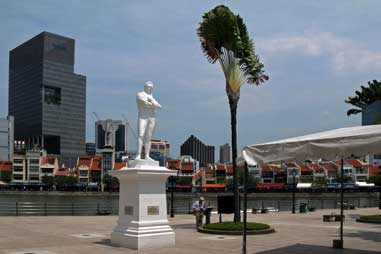 the Port of Singapore
harbour facilities. There was also a severe shortage of food leading to malnutrition,
disease, and rampant crime and violence. High food prices, unemployment, and
workers' discontent culminated in a series of strikes in 1947, causing massive
stoppages in public transport and other services. Britain's failure successfully
to defend Singapore in 1942 had destroyed its credibility as a ruler in the eyes
of Singaporeans, and led to increasing pressure for Singapore's political autonomy. the Port of Singapore
harbour facilities. There was also a severe shortage of food leading to malnutrition,
disease, and rampant crime and violence. High food prices, unemployment, and
workers' discontent culminated in a series of strikes in 1947, causing massive
stoppages in public transport and other services. Britain's failure successfully
to defend Singapore in 1942 had destroyed its credibility as a ruler in the eyes
of Singaporeans, and led to increasing pressure for Singapore's political autonomy.
During the 1950s, partial independence was eventually granted to Singapore, extending to
full self-governance in 1959 under Prime Minister Lee Kuan Yew. Initially
Singapore merged with Malaya and Brunei to form the Federation of Malaysia. But
after internal political disagreements, Singapore separated in 1965, becoming
the independent Republic of Singapore, remaining in the Commonwealth and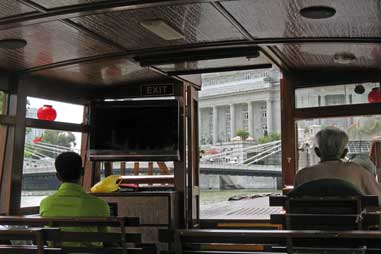 joining
the United Nations. Singapore was ruled by Lee Kuan Yew until 1990. His
authoritarian-liberal regime, with its emphasis on rapid economic growth,
support for business entrepreneurship, and limitations on internal democracy,
shaped Singapore's policies for the next half-century. The island-state progressed as
a centre for trade and finance to become one of the original
four Asian Tiger economies (along with Hong Kong, South Korea,
and Taiwan), attracting international financial
institutions to establish their HQs
in Singapore.
The Port of Singapore with its extended entrepôt trade
emerged as a key transportation and logistics hub, becoming one of the world's
busiest ports along with the service and tourism industries, also growing
immensely during this period.
joining
the United Nations. Singapore was ruled by Lee Kuan Yew until 1990. His
authoritarian-liberal regime, with its emphasis on rapid economic growth,
support for business entrepreneurship, and limitations on internal democracy,
shaped Singapore's policies for the next half-century. The island-state progressed as
a centre for trade and finance to become one of the original
four Asian Tiger economies (along with Hong Kong, South Korea,
and Taiwan), attracting international financial
institutions to establish their HQs
in Singapore.
The Port of Singapore with its extended entrepôt trade
emerged as a key transportation and logistics hub, becoming one of the world's
busiest ports along with the service and tourism industries, also growing
immensely during this period.
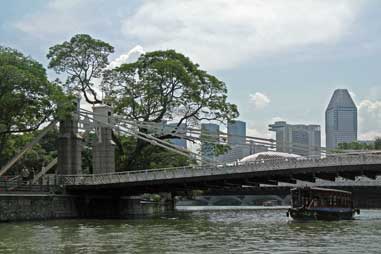 Raffles Quay and Landing Stage:
and here we stood on the embankment at Raffles Landing Place, where the jungle island
village cum colonial trading post cum world-Class port and finance capital had
all begun just under 200 years ago.
At the far end of the quay, the white marble statue of Sir Stamford Raffles (see
above left) (Photo
16 - Raffles' statue) stood imperiously by where the ferries pulled in
at Raffles Landing Stage, commemorating the colonial founder of the Singapore trading
settlement. This was said to be the point at which Raffles, colonial
entrepreneur of extraordinary energy and vision, first stepped ashore on 28
January Raffles Quay and Landing Stage:
and here we stood on the embankment at Raffles Landing Place, where the jungle island
village cum colonial trading post cum world-Class port and finance capital had
all begun just under 200 years ago.
At the far end of the quay, the white marble statue of Sir Stamford Raffles (see
above left) (Photo
16 - Raffles' statue) stood imperiously by where the ferries pulled in
at Raffles Landing Stage, commemorating the colonial founder of the Singapore trading
settlement. This was said to be the point at which Raffles, colonial
entrepreneur of extraordinary energy and vision, first stepped ashore on 28
January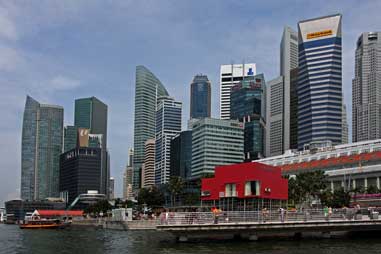 1819 and concluded the first treaty with the local rulers. The plaque on
the statue at the landing site commemorating this first landing in Singapore,
records that With genius and perception, Raffles changed the destiny of
Singapore from an obscure fishing village to a great seaport and modern
metropolis. How would Raffles have reacted if he could
now see what the small trading settlement he had founded in 1819 had developed
into? Imperialist that he was, he would probably have been unsurprised at how
far his colony had progressed from its humble beginnings. Having photographed His Statue against the backdrop of Raffles Place
Central Business District sky-scrapers, we booked our places on the bum-boat
cruise along the Singapore River. 1819 and concluded the first treaty with the local rulers. The plaque on
the statue at the landing site commemorating this first landing in Singapore,
records that With genius and perception, Raffles changed the destiny of
Singapore from an obscure fishing village to a great seaport and modern
metropolis. How would Raffles have reacted if he could
now see what the small trading settlement he had founded in 1819 had developed
into? Imperialist that he was, he would probably have been unsurprised at how
far his colony had progressed from its humble beginnings. Having photographed His Statue against the backdrop of Raffles Place
Central Business District sky-scrapers, we booked our places on the bum-boat
cruise along the Singapore River.
 Cruise along the Singapore River:
to begin with, we had the open-sided boat almost to ourselves (see above right), and were able to move freely from side to side, photographing the
buildings, sky-line and bridges as we passed. The morning light was glorious,
and we took full advantage of all the photographic opportunities. The
sky-scrapers of the Raffles Place Central Business District towered overhead
(Photo
17 - Riverside skyscrapers) as we passed under Cavenagh Bridge
(Photo
18 - Cavenagh Bridge) (see above left). This suspension
bridge was constructed in 1869 with steel castings from Scotland which were
shipped out to Singapore and assembled on site Cruise along the Singapore River:
to begin with, we had the open-sided boat almost to ourselves (see above right), and were able to move freely from side to side, photographing the
buildings, sky-line and bridges as we passed. The morning light was glorious,
and we took full advantage of all the photographic opportunities. The
sky-scrapers of the Raffles Place Central Business District towered overhead
(Photo
17 - Riverside skyscrapers) as we passed under Cavenagh Bridge
(Photo
18 - Cavenagh Bridge) (see above left). This suspension
bridge was constructed in 1869 with steel castings from Scotland which were
shipped out to Singapore and assembled on site by convict labour. It was built
to connect the colonial administrative district on the north bank directly with
the developing commercial district on the southern side, replacing a detour via
a neighbouring bridge or a boat crossing. Beyond the Fullerton Hotel, we pulled
into a quay on the southern bank (see above right) (Photo
19 - Merlion Hotel) close to the Merlion statue, the official
symbol of Singapore with head of a lion and body of a fish. Opposite on the
north bank, the distinctive armadillo-shaped $600 million Esplanade
Theatres-on-the-Bay performing arts centre stood out (see left) (Photo
20 - Esplanade Theatres-on-the-Bay). The southern embankment was
dominated by rows of skyscraper blocks towering overhead as the ferry passed
along the river (Photo
21 - Southern embankment), accommodating the offices of financial institutions
based in Singapore's business district. The river now opened out by convict labour. It was built
to connect the colonial administrative district on the north bank directly with
the developing commercial district on the southern side, replacing a detour via
a neighbouring bridge or a boat crossing. Beyond the Fullerton Hotel, we pulled
into a quay on the southern bank (see above right) (Photo
19 - Merlion Hotel) close to the Merlion statue, the official
symbol of Singapore with head of a lion and body of a fish. Opposite on the
north bank, the distinctive armadillo-shaped $600 million Esplanade
Theatres-on-the-Bay performing arts centre stood out (see left) (Photo
20 - Esplanade Theatres-on-the-Bay). The southern embankment was
dominated by rows of skyscraper blocks towering overhead as the ferry passed
along the river (Photo
21 - Southern embankment), accommodating the offices of financial institutions
based in Singapore's business district. The river now opened out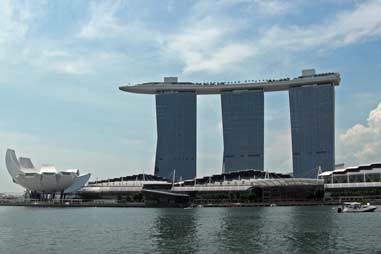 into the wide
area of water of Marina Bay which was over-towered on the southern side by further
distinctive office-block skyscrapers (Photo
22 - Marina Bay skyscrapers) (see right). But eclipsing all of these for attention were the
three enormous towers of the Marina Bay Sands resort-complex, whose tops are
linked by an ocean liner-shaped roof structure (Photo
23 - Marina Bay Sands resort) (see left); this was one of Singapore's iconic structures which seemed to be visible
from so many quarters of the city. Alongside, the Marina Bay Sands
dwarfed the Art-Science Museum, another distinctive modernistic structure
resembling the opening petals of an enormous Lotus flower (see left). into the wide
area of water of Marina Bay which was over-towered on the southern side by further
distinctive office-block skyscrapers (Photo
22 - Marina Bay skyscrapers) (see right). But eclipsing all of these for attention were the
three enormous towers of the Marina Bay Sands resort-complex, whose tops are
linked by an ocean liner-shaped roof structure (Photo
23 - Marina Bay Sands resort) (see left); this was one of Singapore's iconic structures which seemed to be visible
from so many quarters of the city. Alongside, the Marina Bay Sands
dwarfed the Art-Science Museum, another distinctive modernistic structure
resembling the opening petals of an enormous Lotus flower (see left).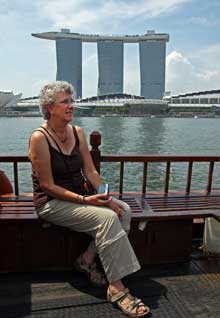
The boat turned in the broad waters of Marina Bay
(Photo
24 - Turning in Marina Bay) to begin the return leg along the river
through the canyon of skyscrapers,
picking up more passengers at quays along along the way. Opposite Raffles Landing Stage, the
bum-boat passed the attractively restored former shop-houses and go-downs of
Boat Quay, now lined with colourful riverside restaurants. Just before Elgin
Bridge, the boat passed on the northern side the Singapore Parliament Building,
which the boat's commentary described in glowingly idealistic terms; doubtless
during the days of Lee Kuan Yew's iron rule, its supposed democratic role was
rather more token than actual. And still the Marina Bay Sands structure towered
above other buildings to dominate the skyline (see right) (Photo
25- Marina Bay Sands dominating skyline). The boat now passed under the sturdy concrete
Elgin Bridge, the original of which was the first permanent bridge across the
river; the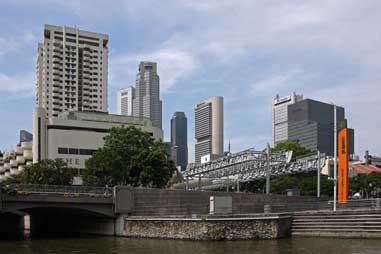 two roads leading to it were accordingly named
North Bridge Road and South Bridge Road.
With the foundation of the colony in 1819, Raffles issued an instruction that a
bridge be built as soon as possible across the Singapore River to link the town planned for the
Chinese community on the southern side of the river to another intended for the
Malays on the northern side. In 1822, a wooden footbridge was
built, and was replaced by a further wooden bridge in 1844. This was demolished
in 1862 and in its place an iron bridge
was built and named Elgin Bridge after the Governor General of
India, Earl Elgin; this was replaced in 1929 by the present
single-arch concrete box-girder bridge, which still connects the Chinese and Indian quarters of the city.
Beyond further bridges (see left) (Photo
26- River Bridges), the boat passed along the more modernistic area
and shopping centres opposite to and beyond Clarke Quay (Photo
27- Riverside shopping centres), where the
former 19th century go-downs had been restored as riverside restaurants and
shops (Photo
28 - Former go-downs). We continued to take many photos on both sides of the river
(Photo
29 - Along the river), as the boat
turned to head back downstream to Raffles Landing Stage and other cruise boats
passed by. Here we alighted by the
Raffles statue two roads leading to it were accordingly named
North Bridge Road and South Bridge Road.
With the foundation of the colony in 1819, Raffles issued an instruction that a
bridge be built as soon as possible across the Singapore River to link the town planned for the
Chinese community on the southern side of the river to another intended for the
Malays on the northern side. In 1822, a wooden footbridge was
built, and was replaced by a further wooden bridge in 1844. This was demolished
in 1862 and in its place an iron bridge
was built and named Elgin Bridge after the Governor General of
India, Earl Elgin; this was replaced in 1929 by the present
single-arch concrete box-girder bridge, which still connects the Chinese and Indian quarters of the city.
Beyond further bridges (see left) (Photo
26- River Bridges), the boat passed along the more modernistic area
and shopping centres opposite to and beyond Clarke Quay (Photo
27- Riverside shopping centres), where the
former 19th century go-downs had been restored as riverside restaurants and
shops (Photo
28 - Former go-downs). We continued to take many photos on both sides of the river
(Photo
29 - Along the river), as the boat
turned to head back downstream to Raffles Landing Stage and other cruise boats
passed by. Here we alighted by the
Raffles statue to walk back along the
tree-shaded north embankment (Photo
30 - Tree-shaded north embankment). The river cruise
had been an invaluable experience, giving us a fulsome insight and introduction
to Singapore's history, its modern heritage, and its contrasting architectural sky-line with modern skyscrapers towering over restored riverside go-downs
(Photo
31 - Contrasting architectural sky-line). And
the gloriously clear Singapore light had provided wonderful opportunities from
the river for a wealth of photographic treasures. to walk back along the
tree-shaded north embankment (Photo
30 - Tree-shaded north embankment). The river cruise
had been an invaluable experience, giving us a fulsome insight and introduction
to Singapore's history, its modern heritage, and its contrasting architectural sky-line with modern skyscrapers towering over restored riverside go-downs
(Photo
31 - Contrasting architectural sky-line). And
the gloriously clear Singapore light had provided wonderful opportunities from
the river for a wealth of photographic treasures.
 A much-needed drink
at river-side restaurant: as we crossed Elgin Bridge to the southern
embankment, further photogenic views opened up of the Singapore Parliament building
(Photo
32- Singapore Parliament Building), and the magnificent panorama of Raffles
Place Central Business District tower-blocks (see left), with its foreground
rows of colourful riverside restaurants along the south bank (see above right)
(Photo
33 - Riverside restaurants); and of course the Marina Sands Bay Complex
was still visible in the distance.
Crossing the bridge to the southern side, we dropped down to Boat Quay, and ran
the gauntlet of girls urging us into their restaurants. Succumbing to the heat
and the temptation of a beer, we took a seat in a pleasantly ventilated
riverside restaurant directly opposite the Raffles statue and Parliament
(see below left) (Photo
34 - Riverside restaurant) and
looking out along the magnificent sweep of the river; the distinctive A much-needed drink
at river-side restaurant: as we crossed Elgin Bridge to the southern
embankment, further photogenic views opened up of the Singapore Parliament building
(Photo
32- Singapore Parliament Building), and the magnificent panorama of Raffles
Place Central Business District tower-blocks (see left), with its foreground
rows of colourful riverside restaurants along the south bank (see above right)
(Photo
33 - Riverside restaurants); and of course the Marina Sands Bay Complex
was still visible in the distance.
Crossing the bridge to the southern side, we dropped down to Boat Quay, and ran
the gauntlet of girls urging us into their restaurants. Succumbing to the heat
and the temptation of a beer, we took a seat in a pleasantly ventilated
riverside restaurant directly opposite the Raffles statue and Parliament
(see below left) (Photo
34 - Riverside restaurant) and
looking out along the magnificent sweep of the river; the distinctive
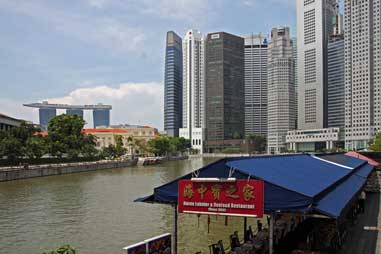 ocean-liner
profile of the Marina Bay Sands topping its three towers stood majestically
above surrounding buildings. This riverside prospect through the red paper
lanterns decorating the restaurant terrace (Photo
35 - View along river) with Marina Sands Bay gracing the skyline provided yet further photographic opportunity. We sat in the cool shade, enjoying our drinks and
relishing this glorious riverside setting. ocean-liner
profile of the Marina Bay Sands topping its three towers stood majestically
above surrounding buildings. This riverside prospect through the red paper
lanterns decorating the restaurant terrace (Photo
35 - View along river) with Marina Sands Bay gracing the skyline provided yet further photographic opportunity. We sat in the cool shade, enjoying our drinks and
relishing this glorious riverside setting.
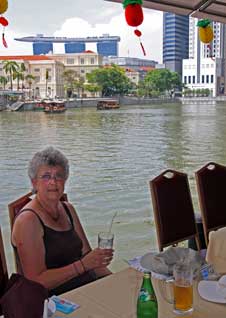 Jamae Mosque in Chinatown district along South Bridge Road:
back up at the bridge, we turned south along South Bridge Road, a rather mundane street along this stretch;
the little traffic on a Sunday afternoon
included a cycling municipal street cleaner (Photo
36 - Cycling street cleaner). After crossing Canal Street
however, we were walking along a canyon of lofty sky-scraper office-blocks, some
with their vertical outline interrupted by roof-gardens. Further along we
entered Singapore's Chinatown district, occupied from the colony's earliest days
by boatloads of Chinese immigrants who flooded in as labourers or merchants.
Once off the main road, the area was a maze of narrow back streets. It was
occupied not only by Chinese but also Indian immigrants, and dotted around the
area were temples and shrines of their various faiths. Further along beyond
Cross Street, at the corner of the appropriately named Mosque Street, we found
the prominent landmark of the Jamae Mosque. This was one of the earliest mosques
in Singapore, established in 1826 by the Chulias, Tamil Muslims from the coast
of South India, who came to Singapore as traders and money-changers. Masjid
Jamae has an eclectic Jamae Mosque in Chinatown district along South Bridge Road:
back up at the bridge, we turned south along South Bridge Road, a rather mundane street along this stretch;
the little traffic on a Sunday afternoon
included a cycling municipal street cleaner (Photo
36 - Cycling street cleaner). After crossing Canal Street
however, we were walking along a canyon of lofty sky-scraper office-blocks, some
with their vertical outline interrupted by roof-gardens. Further along we
entered Singapore's Chinatown district, occupied from the colony's earliest days
by boatloads of Chinese immigrants who flooded in as labourers or merchants.
Once off the main road, the area was a maze of narrow back streets. It was
occupied not only by Chinese but also Indian immigrants, and dotted around the
area were temples and shrines of their various faiths. Further along beyond
Cross Street, at the corner of the appropriately named Mosque Street, we found
the prominent landmark of the Jamae Mosque. This was one of the earliest mosques
in Singapore, established in 1826 by the Chulias, Tamil Muslims from the coast
of South India, who came to Singapore as traders and money-changers. Masjid
Jamae has an eclectic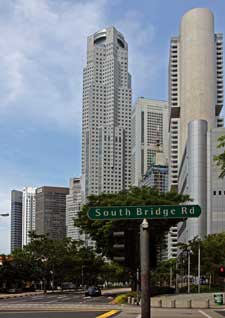 architectural style, borrowing elements from both East and
West, which reflects the architectural styles of 1830s Singapore. The present
structure remains virtually unchanged since its foundation: worshippers enter
the mosque through a gateway framed by two minarets topped by onion domes
and a miniature palace façade based on South Indian Indo-Islamic influence. The mosque's compound with covered
foyer leads to the two prayer halls and shrine which in contrast are
Neo-Classical in style with Doric columns and large windows with Chinese green-glazed tiles. architectural style, borrowing elements from both East and
West, which reflects the architectural styles of 1830s Singapore. The present
structure remains virtually unchanged since its foundation: worshippers enter
the mosque through a gateway framed by two minarets topped by onion domes
and a miniature palace façade based on South Indian Indo-Islamic influence. The mosque's compound with covered
foyer leads to the two prayer halls and shrine which in contrast are
Neo-Classical in style with Doric columns and large windows with Chinese green-glazed tiles.
Large numbers of Muslims were gathered here, but visitors seemed to be welcomed. Removing our
shoes, and Sheila covering her shoulders with a large scarf she routinely
carries for such religious visits, we rather hesitantly walked inside. Some of
the local Muslims were gathered in social groups, others were kneeling and
bowing at their devotions. Not wishing to intrude, we made to leave, but were
approached by an iman who asked if we had any questions. Not
wanting to show any prejudice against Islam,
Paul duly asked about the customs and beliefs of their faith. The iman
was clearly a man on a mission to refute the bad press that Islam now routinely
attracted, and to educate non- believers in the benign attributes of the Muslim
faith. He insisted that other peoples' gods were welcome in the apparently
exclusive pantheon of Allah and Muhammad,
albeit with bit-parts; clearly believing we were Catholics, he even stressed
there was a place for the Virgin Mary, providing of course that Jesus owned up
to his deceit and admitted that he was not the Son of God! With our agnostic
leanings, somehow we were not
persuaded by such condescending bigotry, particularly given the seemingly world-wide
ultra-extremist ranting and terror inspired by Islam. So changing the subject,
Paul countered by asking if young people came to the mosque to be taught the
ways of peace and understanding; of course, the iman replied. Paul was sufficiently tactful to avoid a supplemental
question as to whether terrorism was also on their curriculum; we made a
tactical withdrawal to retrieve our shoes, and move on. believers in the benign attributes of the Muslim
faith. He insisted that other peoples' gods were welcome in the apparently
exclusive pantheon of Allah and Muhammad,
albeit with bit-parts; clearly believing we were Catholics, he even stressed
there was a place for the Virgin Mary, providing of course that Jesus owned up
to his deceit and admitted that he was not the Son of God! With our agnostic
leanings, somehow we were not
persuaded by such condescending bigotry, particularly given the seemingly world-wide
ultra-extremist ranting and terror inspired by Islam. So changing the subject,
Paul countered by asking if young people came to the mosque to be taught the
ways of peace and understanding; of course, the iman replied. Paul was sufficiently tactful to avoid a supplemental
question as to whether terrorism was also on their curriculum; we made a
tactical withdrawal to retrieve our shoes, and move on.
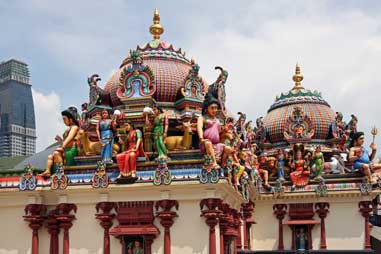 Sri Mariamann Hindu Temple:
on the next corner, between the again appropriately named side-streets of Pagoda Street and Temple Street, we
reached the highly ornate Sri Mariamann Hindu Temple. This was
Singapore's oldest and most important Hindu temple, serving the majority
Hindu Tamil Singaporeans. It was founded in 1827 by Naraina Pillai, eight
years after the trading settlement's establishment. Pillai was a government
clerk from Penang who arrived in Singapore with Raffles 1819; he went on
to set up the island's first construction
company, and was also involved in the textile trade; rapidly Sri Mariamann Hindu Temple:
on the next corner, between the again appropriately named side-streets of Pagoda Street and Temple Street, we
reached the highly ornate Sri Mariamann Hindu Temple. This was
Singapore's oldest and most important Hindu temple, serving the majority
Hindu Tamil Singaporeans. It was founded in 1827 by Naraina Pillai, eight
years after the trading settlement's establishment. Pillai was a government
clerk from Penang who arrived in Singapore with Raffles 1819; he went on
to set up the island's first construction
company, and was also involved in the textile trade; rapidly
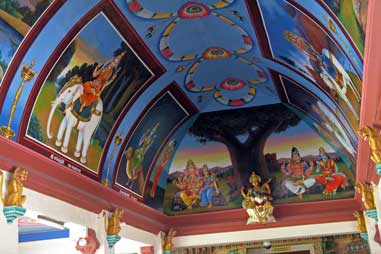 establishing himself
in business, he was identified as a leader of the Indian community. The wealth
and importance of Sri Mariamann Temple was evident from the highly ornate
monumental pagoda-like tower (gopuram) over the entranceway (see above
left) (Photo
37 - Gopuram at Sri Mariamann Hindu Temple), richly embellished with six tiers of sculptures of
Hindu deities and ornamental decorations. Within the walled compound, the temple
consisted of a
combination of covered halls, shrines, and open courtyards. From the gopuram
entrance, a covered hall led directly to the main prayer hall, with richly
ornamented columns and frescoed ceiling (Photo
38 - Hindu mother goddess) (see left). The focus of the main prayer hall
was the central shrine of Mariamman, the Hindu mother goddess predominant in establishing himself
in business, he was identified as a leader of the Indian community. The wealth
and importance of Sri Mariamann Temple was evident from the highly ornate
monumental pagoda-like tower (gopuram) over the entranceway (see above
left) (Photo
37 - Gopuram at Sri Mariamann Hindu Temple), richly embellished with six tiers of sculptures of
Hindu deities and ornamental decorations. Within the walled compound, the temple
consisted of a
combination of covered halls, shrines, and open courtyards. From the gopuram
entrance, a covered hall led directly to the main prayer hall, with richly
ornamented columns and frescoed ceiling (Photo
38 - Hindu mother goddess) (see left). The focus of the main prayer hall
was the central shrine of Mariamman, the Hindu mother goddess predominant in the rural areas of
Tamil Nadu in Southern India. The prayer hall
was surrounded by a series of free-standing shrines, housed in pavilion-like
structures with decorated domed roofs (see above right) (Photo
39 - Domed shrine pavilions). Sri Mariamann Temple is also the site of the annual Thimithi (fire-walking) ceremony
celebrated in November: the priest starts the Thimithi by walking across a
hollow filled with hot burning coals, and is followed by male Hindu devotees
intent on proving their faith and fulfilling their personal pledge. the rural areas of
Tamil Nadu in Southern India. The prayer hall
was surrounded by a series of free-standing shrines, housed in pavilion-like
structures with decorated domed roofs (see above right) (Photo
39 - Domed shrine pavilions). Sri Mariamann Temple is also the site of the annual Thimithi (fire-walking) ceremony
celebrated in November: the priest starts the Thimithi by walking across a
hollow filled with hot burning coals, and is followed by male Hindu devotees
intent on proving their faith and fulfilling their personal pledge.
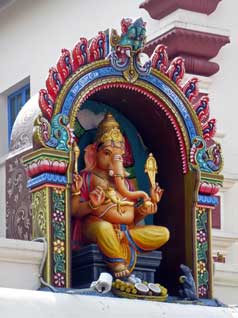 Again with some hesitation, we removed our shoes to enter the temple courtyard. A service
(if that was the correct term for Hindu devotions) had clearly just
finished,
and ladies in sarees were standing waiting to be collected. Inside the prayer
hall was the inner sanctum with Mariamman's shrine, surrounded by open
courtyards in which the smaller shrines were set. Statue-filled niches
surrounded the hall, and the ceilings were richly decorated with portraits of
the Hindu deities; the domed roofs of the smaller shrines
were covered with images of Hindu holy figures.
The intriguing feature of the Hindu religion was the fascinating range and appearance of its
deities
(Photo
40 - Hindu deities): these included a cute, tubby little elephant-god with curly trunk (see
left),
multi-armed and multi-legged deities, and a rather exhibitionist god exposing
his all sans loincloth who, despite his paunch and chubby thighs, was portrayed
showing his gymnastic abilities by putting his toe in his mouth (see right).
Spare pairs of arms were particularly useful if you were a Hindu goddess'
sitar-playing attendant. All of these multifarious and entertaining embodiments
of the Hindu polytheistic pantheon made the Christian monotheistic religion seem
in contrast unimaginatively staid and uninspiring. A few little elephant gods or
multi-limbed exhibitionists would certainly liven up our our local village
church, and
may even attract larger congregations. The only negative feature however of the Hindu
faith was the requirement to walk around with bare feet on stone slabs heated by
the ferocious tropical sun; we could understand now the origins of their
fire-walking ceremonies! We hopped around, trying to tread in the shade, and
photographed all the little elephant gods, and the rooftop collections of
colourful statuary. The adjacency of such contrasting places of
worship truly reflected Again with some hesitation, we removed our shoes to enter the temple courtyard. A service
(if that was the correct term for Hindu devotions) had clearly just
finished,
and ladies in sarees were standing waiting to be collected. Inside the prayer
hall was the inner sanctum with Mariamman's shrine, surrounded by open
courtyards in which the smaller shrines were set. Statue-filled niches
surrounded the hall, and the ceilings were richly decorated with portraits of
the Hindu deities; the domed roofs of the smaller shrines
were covered with images of Hindu holy figures.
The intriguing feature of the Hindu religion was the fascinating range and appearance of its
deities
(Photo
40 - Hindu deities): these included a cute, tubby little elephant-god with curly trunk (see
left),
multi-armed and multi-legged deities, and a rather exhibitionist god exposing
his all sans loincloth who, despite his paunch and chubby thighs, was portrayed
showing his gymnastic abilities by putting his toe in his mouth (see right).
Spare pairs of arms were particularly useful if you were a Hindu goddess'
sitar-playing attendant. All of these multifarious and entertaining embodiments
of the Hindu polytheistic pantheon made the Christian monotheistic religion seem
in contrast unimaginatively staid and uninspiring. A few little elephant gods or
multi-limbed exhibitionists would certainly liven up our our local village
church, and
may even attract larger congregations. The only negative feature however of the Hindu
faith was the requirement to walk around with bare feet on stone slabs heated by
the ferocious tropical sun; we could understand now the origins of their
fire-walking ceremonies! We hopped around, trying to tread in the shade, and
photographed all the little elephant gods, and the rooftop collections of
colourful statuary. The adjacency of such contrasting places of
worship truly reflected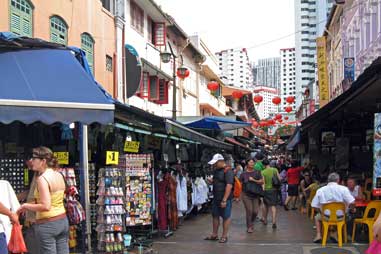 Singapore's remarkable mingling of ethnic and religious communities.
Singapore's remarkable mingling of ethnic and religious communities.
Chinatown Sunday afternoon street markets:
looking along the side streets behind the temple, it was clear that we had found the location of
the Chinatown Sunday afternoon markets. Temple Street itself however seemed to function
as something of a car park, so we retraced our steps to Pagoda Street to walk
along the rows of stalls, the street festooned with red paper lanterns. There were very few tourists about, simply local people enjoying a Sunday
afternoon jaunt through the market
(Photo
41 - Chinatown street markets) (see right). There were all varieties of stalls, mainly
souvenirs and T-shirts, and shop-fronts selling cut-price photographic, computer
and electronic equipment. Carrying his Canon
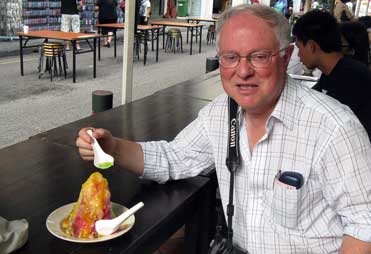 camera, Paul was an obvious
target for the touts, and in a moment of weakness, allowed himself to be drawn
into one of the photographic shops. The salesman was a skilful
operator: he tried to sell us a supplemental lens for the camera, insisting on
fitting one to the camera body and bringing the price down further and further.
We were trapped and nothing that Paul could do, without forthright rudeness and
walking out, would have extricated us. We finally, and with great difficulty,
managed to undo the lens on offer and retrieve the camera body, but the salesman was not
letting us go that easily. What about a Polaroid filter? Paul again made the fatal error of showing momentary interest.
Again the price came down and down, and we finally agreed a price. But when the bill came, it was
far in excess of camera, Paul was an obvious
target for the touts, and in a moment of weakness, allowed himself to be drawn
into one of the photographic shops. The salesman was a skilful
operator: he tried to sell us a supplemental lens for the camera, insisting on
fitting one to the camera body and bringing the price down further and further.
We were trapped and nothing that Paul could do, without forthright rudeness and
walking out, would have extricated us. We finally, and with great difficulty,
managed to undo the lens on offer and retrieve the camera body, but the salesman was not
letting us go that easily. What about a Polaroid filter? Paul again made the fatal error of showing momentary interest.
Again the price came down and down, and we finally agreed a price. But when the bill came, it was
far in excess of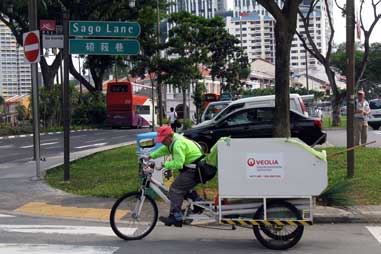 the agreed sum. You can
reclaim the tax at the airport, he claimed; I'll supply the paperwork. But even
knocking off the tax, at two Singapore dollars to the pound, it was
far more than the agreed figure. Too numb to argue, we gullibly gave in; we were
well and truly hooked. Paul had his birthday present, but at what price! the agreed sum. You can
reclaim the tax at the airport, he claimed; I'll supply the paperwork. But even
knocking off the tax, at two Singapore dollars to the pound, it was
far more than the agreed figure. Too numb to argue, we gullibly gave in; we were
well and truly hooked. Paul had his birthday present, but at what price!
Continuing through the stalls more wary now, but still enjoying the market atmosphere,
we walked back and forth along Trengganu Street, looking for a stall selling the ice cream concoctions we had read of.
Most of the food stalls looked distinctly unsavoury, clearly aimed
at tourists, but we eventually found a row of stalls in Smith Street with just
what we wanted. Sheila ordered a Mango Ice Kacang (literally meaning bean ice) (Photo
42 - Mango Ice Kacang) (see above left), a Chinatown ice cream
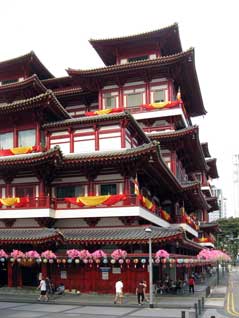 specialty
made up of a pile of crushed ice and ice cream with jelly pieces, fruits, berries, sweet corn
and red beans, all topped with mango sauce. It was deliciously refreshing. specialty
made up of a pile of crushed ice and ice cream with jelly pieces, fruits, berries, sweet corn
and red beans, all topped with mango sauce. It was deliciously refreshing.
Buddha Tooth Relic Temple:
back along at South Bridge Road and passing another cycling street cleaner (see
above right), we considered leaving the market area believing we had covered most of what was to
be seen. We crossed the road, intending to head eastward in search of other
parts of Chinatown. But from this position, we could now see on the corner of
Sago Lane a huge and elaborate Chinese temple, resembling in shape a design from
Wedgewood plates or a backdrop for a production of the Mikado (see left).
This we had to investigate further, and crossed back for a closer look at what
was labelled on our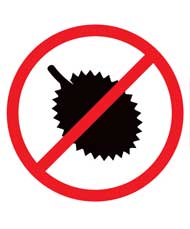 map as the Buddha Tooth Relic Temple. The temple
was designed by the Chief Abbot Venerable Shi Fa Zhao in traditional Tang
Dynasty architectural style, and was built in 2007 to house the eponymous left
canine tooth relic of Buddha, which had been recovered from his funeral pyre in Kushinagar, India. The Buddha Tooth Relic is housed in a giant
stupa, a
dome-shaped structure for containing relics, weighing 3,500 kilograms and made from
320kgs of gold, mostly donated by Buddhist devotees. As well as housing
this scared relic, the temple also serves as a Buddhist cultural and educational
centre promoting the legacy of Buddha's teachings. The exterior of
this huge multi-galleried Buddhist temple was draped with pink paper blossom (Photo
43 - Buddha Tooth Relic Temple), and large numbers of people were
gathered around the outer courtyards. We entered to find a large congregation
taking part in a Buddhist ceremony. No one seemed to regard our presence as an
intrusion and other visitors were examining the
shrine and exhibits (Photo
44 - Buddhist shrine). We took some photos of the richly
decorated interior but
withdrew, feeling that we were intrusive voyeurs on what was clearly a deeply
religious occasion. The nearby car park was full, with a number of coaches which
had brought the devotees to what was clearly a special event. Given the scale of
the temple and the numbers of worshippers attending, it was obvious that the Buddha's tooth
relic was a prize draw!
map as the Buddha Tooth Relic Temple. The temple
was designed by the Chief Abbot Venerable Shi Fa Zhao in traditional Tang
Dynasty architectural style, and was built in 2007 to house the eponymous left
canine tooth relic of Buddha, which had been recovered from his funeral pyre in Kushinagar, India. The Buddha Tooth Relic is housed in a giant
stupa, a
dome-shaped structure for containing relics, weighing 3,500 kilograms and made from
320kgs of gold, mostly donated by Buddhist devotees. As well as housing
this scared relic, the temple also serves as a Buddhist cultural and educational
centre promoting the legacy of Buddha's teachings. The exterior of
this huge multi-galleried Buddhist temple was draped with pink paper blossom (Photo
43 - Buddha Tooth Relic Temple), and large numbers of people were
gathered around the outer courtyards. We entered to find a large congregation
taking part in a Buddhist ceremony. No one seemed to regard our presence as an
intrusion and other visitors were examining the
shrine and exhibits (Photo
44 - Buddhist shrine). We took some photos of the richly
decorated interior but
withdrew, feeling that we were intrusive voyeurs on what was clearly a deeply
religious occasion. The nearby car park was full, with a number of coaches which
had brought the devotees to what was clearly a special event. Given the scale of
the temple and the numbers of worshippers attending, it was obvious that the Buddha's tooth
relic was a prize draw!
 Chinatown Complex Food Centre and the dreaded Durians, King of Fruits:
just behind the Buddhist temple, we found the huge indoor market of the Chinatown
Complex Food Centre. With curiosity renewed, we entered this wholly functional
complex of food stalls, and one of our first encounters helped to clear up an
aspect of Singaporean daily life that had been puzzling us: this morning in the lift lobby on
our floor at the YMCA, below a sign forbidding smoking in the hotel, was a sign
forbidding the presence of Durians alongside a symbol resembling a crossed-out
spiky entity from a space Chinatown Complex Food Centre and the dreaded Durians, King of Fruits:
just behind the Buddhist temple, we found the huge indoor market of the Chinatown
Complex Food Centre. With curiosity renewed, we entered this wholly functional
complex of food stalls, and one of our first encounters helped to clear up an
aspect of Singaporean daily life that had been puzzling us: this morning in the lift lobby on
our floor at the YMCA, below a sign forbidding smoking in the hotel, was a sign
forbidding the presence of Durians alongside a symbol resembling a crossed-out
spiky entity from a space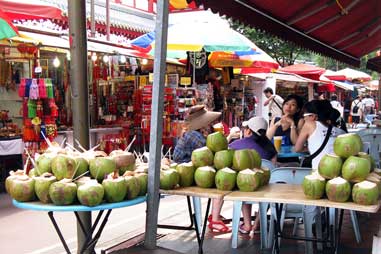 invaders game (see above right). We had seen the same
sign and symbol on the MRT. But what did this mysterious sign mean? Here in the
Chinatown Complex Food Centre we found
the answer. Tucked away in an obscure corner of the indoor
market, a stall was piled high with green, spiky,
rugby ball-sized fruits, which the signs proclaimed as Durians, the King of Fruits (Photo
45 - Durians (King of fruits)) (see left).
And a neighbouring stall displayed small dishes of the yellowish Durian fruit,
which sold at highly expensive prices;
a whole one cost $7. But beware: the pervasive foul smell around the stall
explained why the Durian was a forbidden fruit! It was repulsively fetid. We
later learned that, although Durians are for some inexplicable reason popular
with locals, their persistent foul stench of raw sewage, which may linger for
several days, causes them understandably to be banned in public buildings and on
the MRT. Standing by the stall of Durians, we fully appreciated why, and duly
photographed the offending fruit. invaders game (see above right). We had seen the same
sign and symbol on the MRT. But what did this mysterious sign mean? Here in the
Chinatown Complex Food Centre we found
the answer. Tucked away in an obscure corner of the indoor
market, a stall was piled high with green, spiky,
rugby ball-sized fruits, which the signs proclaimed as Durians, the King of Fruits (Photo
45 - Durians (King of fruits)) (see left).
And a neighbouring stall displayed small dishes of the yellowish Durian fruit,
which sold at highly expensive prices;
a whole one cost $7. But beware: the pervasive foul smell around the stall
explained why the Durian was a forbidden fruit! It was repulsively fetid. We
later learned that, although Durians are for some inexplicable reason popular
with locals, their persistent foul stench of raw sewage, which may linger for
several days, causes them understandably to be banned in public buildings and on
the MRT. Standing by the stall of Durians, we fully appreciated why, and duly
photographed the offending fruit.
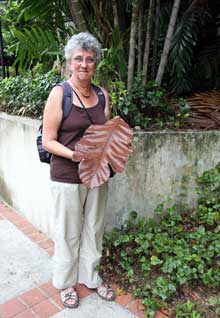 A final tour of the Chinatown Market stalls:
we walked around the functional stalls of hardware, bric-a-brac, and Bollywood DVDs, and
stalls of meat and vegetable. Here Paul found a small snack of curried
pasty to keep him going. Along Sago Street, we found another curiosity:
we had earlier seen youngsters sucking drinks through straws from large green fruit shells. At
a stall here, we discovered that these were unripe green coconuts; the top was
cut away and the inside partially scooped out, leaving the juice and fleshy
fruit. We had to try this. The stall lady was very obliging and brought us
2 straws, and we took it in turn sucking out the sweet,
refreshing coconut milk (Photo
46 - Coconut milk drink) (see above right). Passing other unusual stalls
selling among other things chop sticks and samples of Chinese handwritten
script, we returned to South Bridge Road to pick up our onward route where we
had left it a A final tour of the Chinatown Market stalls:
we walked around the functional stalls of hardware, bric-a-brac, and Bollywood DVDs, and
stalls of meat and vegetable. Here Paul found a small snack of curried
pasty to keep him going. Along Sago Street, we found another curiosity:
we had earlier seen youngsters sucking drinks through straws from large green fruit shells. At
a stall here, we discovered that these were unripe green coconuts; the top was
cut away and the inside partially scooped out, leaving the juice and fleshy
fruit. We had to try this. The stall lady was very obliging and brought us
2 straws, and we took it in turn sucking out the sweet,
refreshing coconut milk (Photo
46 - Coconut milk drink) (see above right). Passing other unusual stalls
selling among other things chop sticks and samples of Chinese handwritten
script, we returned to South Bridge Road to pick up our onward route where we
had left it a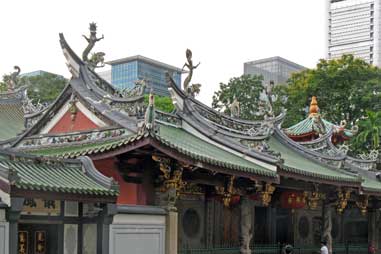 half hour earlier. half hour earlier.
Telok Ayer Street:
crossing the main road, we worked our way through the back streets which led up steps to
a hillock with the gardens of Telok Ayer Green; these were planted with exotic
tropical trees and shrubs, the sort that back home are small house plants but
here were huge trees (Photo
47 - Singaporean tropical trees). Sheila was photographed
holding a massive fallen leaf from one of the trees (see left); this was an
autumn botanising with a difference. Steps led down the far side into Telok Ayer Street,
the primary area set aside by Raffles for
the Chinese community. The area now is built on reclaimed land, but originally
was on the coastline at the main landing site for Chinese immigrants. Telok Ayer
Street formed the original focal point of settlement and
development of the Chinese immigrant community in early Singapore, becoming the
main commercial and residential thoroughfare in Chinatown.
Temples and mosques are plentiful in this area, built by Chinese
and Muslim immigrants to show their gratitude for a safe sea passage to Singapore.
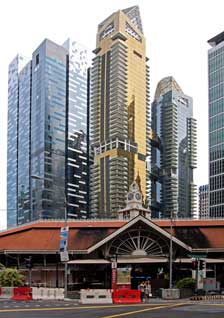 Taoist shrine-temple of Thian Hock Keng:
at the corner where we emerged into Telok Ayer Street, we reached the Taoist
shrine-temple of Thian Hock Keng,
meaning Palace of Heavenly Happiness (see above right). This was the oldest and most important
temple in Singapore, built to serve the local Hokkien community of immigrants
from Southern China and dedicated to Matsu, Goddess
of the Sea, Queen of Heaven and Patroness of Sailors. The temple is now located
on Telok Ayer Street, but before land reclamation Taoist shrine-temple of Thian Hock Keng:
at the corner where we emerged into Telok Ayer Street, we reached the Taoist
shrine-temple of Thian Hock Keng,
meaning Palace of Heavenly Happiness (see above right). This was the oldest and most important
temple in Singapore, built to serve the local Hokkien community of immigrants
from Southern China and dedicated to Matsu, Goddess
of the Sea, Queen of Heaven and Patroness of Sailors. The temple is now located
on Telok Ayer Street, but before land reclamation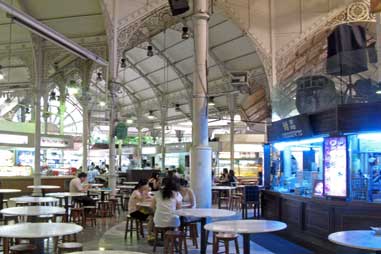 work began in the 1880s, this area used
on the waterfront. When originally built in the 1820s, the Thian Hock Keng Temple faced the sea, where seafarers and immigrants could give thanks to the
sea goddess for a safe sea passage on their arrival at Singapore. Building
materials for the temple and a statue of Matsu were brought over from China, and
the statue enshrined in the main hall of the temple in 1840. The exterior of the
temple, originally decorated with carved wooden dragons, was now unfortunately
beginning to succumb to dereliction; it was today all locked up and badly in
need of renovation. work began in the 1880s, this area used
on the waterfront. When originally built in the 1820s, the Thian Hock Keng Temple faced the sea, where seafarers and immigrants could give thanks to the
sea goddess for a safe sea passage on their arrival at Singapore. Building
materials for the temple and a statue of Matsu were brought over from China, and
the statue enshrined in the main hall of the temple in 1840. The exterior of the
temple, originally decorated with carved wooden dragons, was now unfortunately
beginning to succumb to dereliction; it was today all locked up and badly in
need of renovation.
Telok Ayer covered market and food hall: along to the main
thoroughfare of Cross Street, back amid the over-towering forest of glitzy tower
blocks, the road was partially dug up with construction work for a new MRT line
extension. We followed the road across a couple of intersections to find
the Lau Pa Sat (meaning 'old market' in the Hokkien dialect) covered food hall
market. Set amid the modernistic urban landscape of sky-scrapers (see left)
(Photo
48 - Telok Ayer covered market), this
wonderfully preserved prefabricated cast-iron and timber octagonal structure
topped by clock-tower, originally designed by the colonial government's
municipal engineer and built in 1894, now houses the Telok Ayer Market and food
hall. The interior is surprisingly light and airy with its elegantly slender cast-iron support-pillars,
lofty timber-lined vaulted ceilings and filigree decorative features
(Photo
49 - Telok Ayer food hall interior) (see above right).
The food-hall is filled with food stalls selling all kinds of straightforward
oriental cuisine, with groups of tables for diners to eat their plates of
noodles, rice, barbecued sea-food and all manner
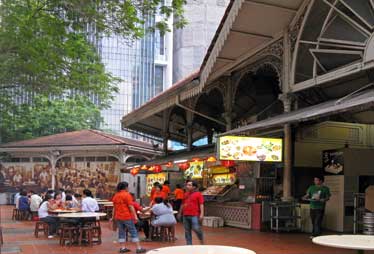 else of the many culinary
traditions represented in Singapore. All of this was familiar from last
evening's food-hall experience. What else of the many culinary
traditions represented in Singapore. All of this was familiar from last
evening's food-hall experience. What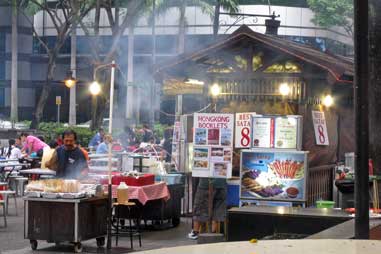 was however new for us were the archetypally Singaporean satay stalls, set out in the outdoor seating area of
Boon Tat Street alongside the covered market.
was however new for us were the archetypally Singaporean satay stalls, set out in the outdoor seating area of
Boon Tat Street alongside the covered market.
Weary, hot and sticky from our long day's
explorations and markets ambling in Singapore's overbearing tropical humidity,
we gratefully sat for our meal with our mugs of Tiger beer, bought from ladies
known affectionately by locals as beer aunties, who made their rounds of
the tables selling cheap drinks. After our huge breakfast
this morning, we had lunched on snacks to save appetite for our promised
traditional Singaporean satay supper here at the Boon Tat street market stalls
(see left). We watched with fascination the elderly gents
fanning their barbecue coals (see above right) (Photo
50 - Fanning the barbecue coals) and layering on kebabs of shredded chicken and beef
meat and enormous, skewered, unshelled tiger-prawns. Smoke from the barbecue
trolleys wafted over the food-hall, adding to the atmosphere as more diners
filled the outdoor seating (see left and right below).
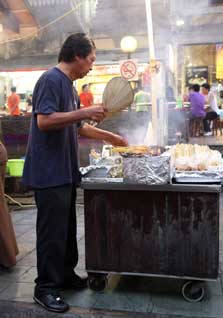 We firstly selected a stall selling grilled
tiger prawns, and ordered two each with a plate of vermicelli noodles. The
prawns were very messy to shell, but unbelievably
delicious with their thick,
meaty and really tasty flesh. Having cleared our dish of noodles, we moved onto
our second course: at another stall we ordered ten satay kebabs with their
accompanying little dishes of spicy
peanut sauce
(Photo
51 - Satay kebabs and fried rice), and a plate of egg fried rice
brought from a further stall, together with more mugs of Tiger beer
(Photo
52 - Tiger beer). We had
chosen our seats well, immediately alongside the elderly gent who was grilling
the satay sticks and frantically fanning the barbecue coals
(Photo
53 - Satay barbecue). As we eat our
mouth-wateringly delicious supper, Paul continued taking endless photos among the
atmospheric lights of the now dark evening. We firstly selected a stall selling grilled
tiger prawns, and ordered two each with a plate of vermicelli noodles. The
prawns were very messy to shell, but unbelievably
delicious with their thick,
meaty and really tasty flesh. Having cleared our dish of noodles, we moved onto
our second course: at another stall we ordered ten satay kebabs with their
accompanying little dishes of spicy
peanut sauce
(Photo
51 - Satay kebabs and fried rice), and a plate of egg fried rice
brought from a further stall, together with more mugs of Tiger beer
(Photo
52 - Tiger beer). We had
chosen our seats well, immediately alongside the elderly gent who was grilling
the satay sticks and frantically fanning the barbecue coals
(Photo
53 - Satay barbecue). As we eat our
mouth-wateringly delicious supper, Paul continued taking endless photos among the
atmospheric lights of the now dark evening. 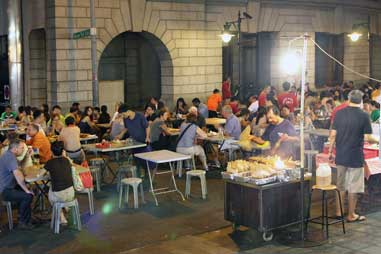 It was a totally exhilarating
experience, enjoying a wonderfully traditional Singaporean supper amid the
absorbing atmosphere of the satay stalls and food market (Photo
54 - Satay supper), now crowded with mainly local
people. Taking our final photos of the satay stalls and the
early evening crowds of Singaporeans happily tucking into their suppers (Photo
55 - Early evening crowds) (see right), we walked back
through the covered Lau Pa Sat market, and along the canyon of tower blocks,
largely darkened on a Sunday evening, towards Raffles Place MRT station. It was a totally exhilarating
experience, enjoying a wonderfully traditional Singaporean supper amid the
absorbing atmosphere of the satay stalls and food market (Photo
54 - Satay supper), now crowded with mainly local
people. Taking our final photos of the satay stalls and the
early evening crowds of Singaporeans happily tucking into their suppers (Photo
55 - Early evening crowds) (see right), we walked back
through the covered Lau Pa Sat market, and along the canyon of tower blocks,
largely darkened on a Sunday evening, towards Raffles Place MRT station.
Two stops north to Dhoby Ghaut, our now familiar
home station, we returned to our room at the YMCA to freshen up. As we walked
across to the Irish pub on the far side of Bras Basah Road, a helpful
Singaporean lady pointed out that if we waited for the Green Man in trying to
cross the road, we should be waiting all evening; the pedestrian crossing did
not operate until after 9-00pm! At the pub, we were welcomed to the bar stools,
having achieved locals status after last night's visit. We ordered our Tiger
beers and sat chatting with one of the barmen. Being a quiet Sunday evening, the
other barman was in less demand for his cocktail-mixing skills tonight. Saying
farewell, we returned to the YMCA, thoroughly exhausted after our full but
wonderfully satisfying day in Singapore's torridly humid tropical heat. Again we
had learned so much and enjoyed many unique experiences.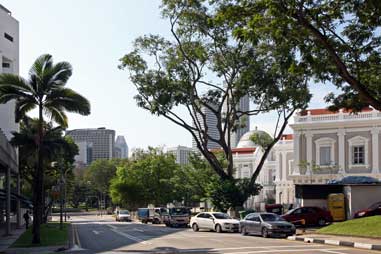
British surrender of Singapore to invading
Japanese in 1942: after a
second night's sleep in our air-conditioned luxury suite, and a solid breakfast
to start the day, we set off for our second and final day in Singapore. We had
to check out, and leave our packed kit in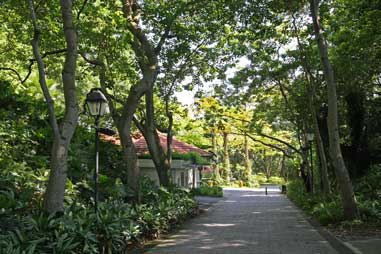 the YMCA's secure luggage store for
the day, to collect early this evening before leaving for the airport and our
homeward overnight flight. the YMCA's secure luggage store for
the day, to collect early this evening before leaving for the airport and our
homeward overnight flight.
Our first visit this morning was to Fort
Channing Park, set on the hill behind the YMCA, for our visit to the preserved
WW2 British military command-post. It was here that the British military
commander, Lt-General Percival took the fateful decision to surrender Singapore
to the Japanese on 15 February 1942. We walked up Fort Channing Road
(see left) past the stately building of the Singapore National Museum (Photo
56 - Singapore National Museum). Steps climbed the
hillside leading through magnificent gardens of exotic tropical trees (see
right)
(Photo
57 - Fort Channing Park): some were
seen in UK as miniature house plants and here grew as huge trees. This morning
the sky was clear and the sun even hotter than ever; we were grateful for the
relief of the trees' shade. The steps led up into the park where the main
visitor attraction was the underground bomb-proof bunker, built in 1936 and
known as the Battle Box, which had housed the British military
command-post during the WW2 defence of Singapore against Japanese invasion.
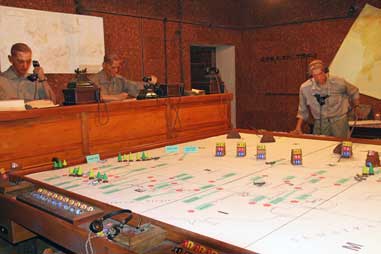 The
Battle Box as Combined Operations Headquarters has been preserved in the state
of 1942 with audio-visual presentations telling the story of events leading up to
the surrender. As we arrived, a group tour was about to begin which we joined as
the young guide issued headphones, with simulated bomb explosions echoing around the underground bunker. The
Battle Box as Combined Operations Headquarters has been preserved in the state
of 1942 with audio-visual presentations telling the story of events leading up to
the surrender. As we arrived, a group tour was about to begin which we joined as
the young guide issued headphones, with simulated bomb explosions echoing around the underground bunker.
Britain's pre-war Far East Strategy: the Singapore Strategy was the cornerstone of
British Imperial defence policy for the British Empire in the Far East during
the late 1930s. This naval defence policy aimed to deter aggression by the
Empire of Japan by providing a well-equipped naval base at Singapore for the
Royal Navy Far East fleet, in order to intercept and defeat a Japanese force
heading south towards India or Australia. Despite Singapore being Britain's
prize Far-East colonial possession, the island was relatively poorly defended on
the landward side, since any Japanese attack was expected to come from the sea; the battle-cruisers
Repulse
and Prince of Wales had already been sunk on their way to Singapore by Japanese air attack
in December 1941. But the Japanese failed to oblige British expectations: their
armies poured irresistibly down the Malayan peninsular from Thailand, taking the
British by surprise to threaten Singapore from the landward side. The heavy
naval guns designed to defend Singapore against Japanese naval attack were
equipped with armour-piercing rather than high-explosive shells, and were almost
useless to repel Japanese troops invading from the north. Japanese forces
crossed the Johor Straits to invade the island of Singapore, and within a week the battle
for Singapore was over, resulting in a humiliating British defeat and surrender.
British and Commonwealth troops suffered heavy losses in the fighting and 1000s
were taken prisoner. Churchill called it the worst disaster and largest
capitulation in British history. the sea; the battle-cruisers
Repulse
and Prince of Wales had already been sunk on their way to Singapore by Japanese air attack
in December 1941. But the Japanese failed to oblige British expectations: their
armies poured irresistibly down the Malayan peninsular from Thailand, taking the
British by surprise to threaten Singapore from the landward side. The heavy
naval guns designed to defend Singapore against Japanese naval attack were
equipped with armour-piercing rather than high-explosive shells, and were almost
useless to repel Japanese troops invading from the north. Japanese forces
crossed the Johor Straits to invade the island of Singapore, and within a week the battle
for Singapore was over, resulting in a humiliating British defeat and surrender.
British and Commonwealth troops suffered heavy losses in the fighting and 1000s
were taken prisoner. Churchill called it the worst disaster and largest
capitulation in British history.
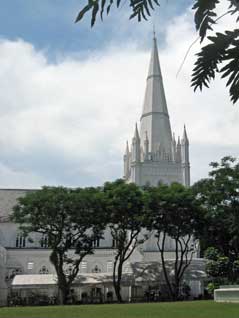 Our visit to the British military command-post: in the Battle Box
presentation, General Percival's final conference at which, after heated
argument and recrimination the decision was taken to surrender, was simulated
by rather less than convincing automated manikins (Photo
58 - Fort Channing simulation) (see above left and right), and with
even more clumsy sound-effects. Percival became a scapegoat for the necessity to
surrender Singapore, and went into POW captivity along with his troops.
Following the surrender, the Singaporean civilian population, particularly the
Chinese, were subjected to massacres and treated with savage brutality, and many
died in captivity as a result. Many of the British and Commonwealth POWs died in
captivity in Changi prison; many others were shipped to Japan for slave labour
or force-marched to work on building the Siam-Burma Death Railway. Singapore
finally returned to British control after Japanese surrender was enforced by the
dropping of atomic bombs on Hiroshima and Nagasaki in August 1945. Yamashita,
the Japanese commander at the capture of Singapore, Our visit to the British military command-post: in the Battle Box
presentation, General Percival's final conference at which, after heated
argument and recrimination the decision was taken to surrender, was simulated
by rather less than convincing automated manikins (Photo
58 - Fort Channing simulation) (see above left and right), and with
even more clumsy sound-effects. Percival became a scapegoat for the necessity to
surrender Singapore, and went into POW captivity along with his troops.
Following the surrender, the Singaporean civilian population, particularly the
Chinese, were subjected to massacres and treated with savage brutality, and many
died in captivity as a result. Many of the British and Commonwealth POWs died in
captivity in Changi prison; many others were shipped to Japan for slave labour
or force-marched to work on building the Siam-Burma Death Railway. Singapore
finally returned to British control after Japanese surrender was enforced by the
dropping of atomic bombs on Hiroshima and Nagasaki in August 1945. Yamashita,
the Japanese commander at the capture of Singapore,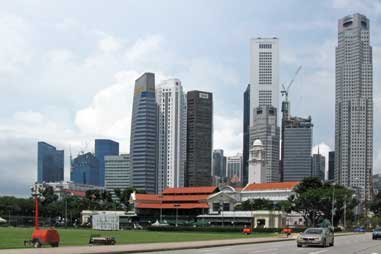 was tried and convicted by a
US military war crimes commission, and was hanged in the Philippines in
February 1946. was tried and convicted by a
US military war crimes commission, and was hanged in the Philippines in
February 1946.
Singapore's Civic District:
we returned downhill through more of the
delightful stepped gardens to Dhoby Ghaut MRT station, and caught the metro
one stop along to City Hall with the intention of seeing a little of Singapore's
Civic District. In the searing heat, we walked past the very English St Andrew's Cathedral
(see left) to find Singapore's grandiose neo-Classical City Hall, built at the
height of British colonial power in 1929. It was here that the Japanese
surrendered to Lord Mountbatten as Supreme Allied Commander Southeast Asia in
1945, and that Lee Kuan Yew declared Singapore's self-governance in 1959. But
rumours of our visit today had spread, and inevitably therefore the builders
were in: the enormous building with its Doric-columned façade, was surrounded by
high fencing enclosing a building site. There was absolutely nothing to be seen
of the entire edifice other than the backdrop of Central Business District sky-scrapers.
Across the busy main road from the government
buildings was the wide open space of green turf, known as the Padang (Malay for
field), an area which Raffles in his plan for Singapore had set aside as public
parkland, and which later formed the cricket pitch for the Singapore
 Cricket Club founded in 1852; more infamously in 1942, it was used by the Japanese
military as the place where the entire European population was rounded up for
interrogation. It was still a sports ground, but now seemed a bizarrely
anachronistic hangover from British colonial days. The skyline above the sports
field was today dominated by the three towers of the ocean liner deck-topped
Marina Bay Sands Resort (Photo
59 - Padang cricket ground) and by the office sky-scrapers of CBD (see
above right). Cricket Club founded in 1852; more infamously in 1942, it was used by the Japanese
military as the place where the entire European population was rounded up for
interrogation. It was still a sports ground, but now seemed a bizarrely
anachronistic hangover from British colonial days. The skyline above the sports
field was today dominated by the three towers of the ocean liner deck-topped
Marina Bay Sands Resort (Photo
59 - Padang cricket ground) and by the office sky-scrapers of CBD (see
above right).
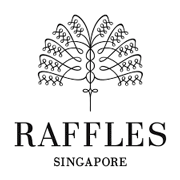 Taking
Tiffin at the Raffles Hotel:
wilting in the hot sun, we walked
along St Andrew's Road and crossed the busy main road to visit the world famous
luxury Raffles Hotel, the emblematic symbol of British colonial rule in
Singapore (see right). Despite the implications of its name, the hotel was in fact
founded, not by Raffles himself, but in1887 by enterprising Armenian hoteliers,
the Sarkies brothers. Over the years, the rich and famous have stayed at the
Raffles Hotel, so we felt it appropriate that we also should take Tiffin there. Taking
Tiffin at the Raffles Hotel:
wilting in the hot sun, we walked
along St Andrew's Road and crossed the busy main road to visit the world famous
luxury Raffles Hotel, the emblematic symbol of British colonial rule in
Singapore (see right). Despite the implications of its name, the hotel was in fact
founded, not by Raffles himself, but in1887 by enterprising Armenian hoteliers,
the Sarkies brothers. Over the years, the rich and famous have stayed at the
Raffles Hotel, so we felt it appropriate that we also should take Tiffin there.
Slightly overawed, we stood by the flawlessly
raked gravel driveway with its surround of palm trees backed by modernistic
sky-scrapers (Photo
60 - Raffles Hotel) (see left). The hotel itself had every appearance of a survival from a more
gentile era, with an exquisitely uniformed and turbaned Indian commissionaire
standing attentively by the front steps ready to leap out and assist arriving
guests from their limousines. Having taken our photos of the magnificent façade, we
brazenly approached the main entrance, but entry was forbidden to all but
residents; the hoi polloi were obliged to go around the side where, amid
beautiful palm trees and gardens of exotic plants, we found the Tiffin Room,
Billiard Room and Palm Court. And alongside, overlooking the lovely cool garden
and fountain, was a delightful shaded terrace
(Photo
61 - Garden terrace at Raffles Hotel); yes, we should take Tiffin here.
Paul walked in, and with due aplomb ordered Earl Grey Tea for milady and a large
Tiger beer for himself. And we sat on the terrace of Raffles Hotel to enjoy this
delightfully civilised interlude in our hot and busy day, an occasion duly recorded on photograph
(Photo
62 - Taking Tiffin at Raffles Hotel). This was a charmingly memorable interlude on the terrace
at Raffles; but the price was equally memorable: $55 for a tray of tea and a beer! in our hot and busy day, an occasion duly recorded on photograph
(Photo
62 - Taking Tiffin at Raffles Hotel). This was a charmingly memorable interlude on the terrace
at Raffles; but the price was equally memorable: $55 for a tray of tea and a beer!
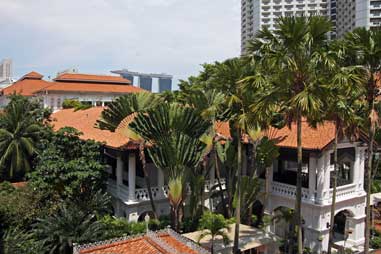 The Raffles Museum:
having taken photos of the uniformed commissionaire on guard at the main entrance
(see right) (Photo
63 - Raffles commissionaire), we walked around to the rear of the hotel to
find the Raffles Hotel Museum, and the avant-garde Raffles Shopping Arcade,
lined with extravagantly expensive designer shops. Up the escalator to the first
and second floors, the veranda gave splendid views over the exclusive hotel
gardens
(Photo
64 - Hotel gardens) with their luxuriant palm trees
(see left) (Photo
65 - Luxuriant palm trees). The second floor
veranda gave perfect tree-top level views of the coconut fruits growing atop the
palm trees
(Photo
66 - Coconut fruits). And in the distance, the three towers of the Marina
Bay Sands resort with its ocean liner top deck stood out clearly above the roofs
and gardens of Raffles Hotel (Photo
67 - Marina Bay Sands resort). Tucked away rather obscurely
on the second floor was the Raffles Hotel Museum, with displays of memorabilia
from distinguished guests who had stayed at the Raffles during the early 20th
century, and a model of the modern hotel. The Raffles Museum:
having taken photos of the uniformed commissionaire on guard at the main entrance
(see right) (Photo
63 - Raffles commissionaire), we walked around to the rear of the hotel to
find the Raffles Hotel Museum, and the avant-garde Raffles Shopping Arcade,
lined with extravagantly expensive designer shops. Up the escalator to the first
and second floors, the veranda gave splendid views over the exclusive hotel
gardens
(Photo
64 - Hotel gardens) with their luxuriant palm trees
(see left) (Photo
65 - Luxuriant palm trees). The second floor
veranda gave perfect tree-top level views of the coconut fruits growing atop the
palm trees
(Photo
66 - Coconut fruits). And in the distance, the three towers of the Marina
Bay Sands resort with its ocean liner top deck stood out clearly above the roofs
and gardens of Raffles Hotel (Photo
67 - Marina Bay Sands resort). Tucked away rather obscurely
on the second floor was the Raffles Hotel Museum, with displays of memorabilia
from distinguished guests who had stayed at the Raffles during the early 20th
century, and a model of the modern hotel.
Lunch at The Banana Leaf Apolo in Little India:
exiting from the exclusivity and peacefulness of the Raffles courtyard and gardens, into the steamy hot and busy
Stamford Road, we walked along to City Hall MRT station. Here amid the welcome
air-conditioned coolness of the station's shopping arcades, we caught the metro
back along to Dhobi Ghaut. Eventually locating the platform for the NE MRT line,
we travelled one further stop along to Little India. This was
 originally the
division of colonial Singapore where, under the Raffles Plan of Singapore,
ethnic Indian immigrants would reside under the British policy of ethnic
segregation. Hindus and Tamil Muslims still make up the majority of the
population in what is now Singapore's most colourful downtown district. originally the
division of colonial Singapore where, under the Raffles Plan of Singapore,
ethnic Indian immigrants would reside under the British policy of ethnic
segregation. Hindus and Tamil Muslims still make up the majority of the
population in what is now Singapore's most colourful downtown district.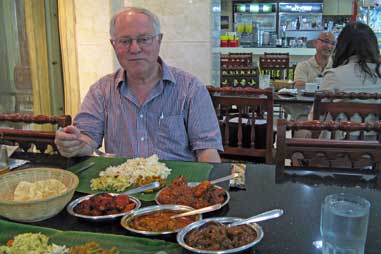
Emerging from Little India MRT station into the
wall of heat, we were faced with all the noise and disruption of major building
sites and excavations from another extension of the MRT system. Eventually
finding our bearings, we walked along Buffalo Street alongside the Tekka Centre
and Indian food market, a busy, bustling complex of stalls selling everything
from sarees, jewellery, sweets, herbal medicines, brass-wares and ornaments. Our plan
was for a late lunch of curry at one of the Indian food halls around the market,
but nothing was immediately apparent. We enquired of a lady stall-holder, and
she directed us further along Race Course Road where we found the
Banana Leaf Apolo, a long-established Indian food hall founded in 1974 by Mr
Chellappan Sankaranathan;
it was exactly what we were looking for. Around the central seating area were
stalls selling dishes of curry of every description from both Southern Indian
vegetarian food to North Indian tandoori dishes. Our initial impression was that
we should select a stall and wait with our tray to be served. But no, we were
directed to sit at one of the tables, and select our choice of meal from a menu.
In the traditional manner, your meal was eaten from a large piece of banana leaf, but at least forks and spoons were provided; as a sop to
modernity, you no longer had to eat your curry and rice using just fingers! We
ordered fish curry, four Apolo masala tiger prawns, a mutton masala and Apolo
chicken curry, with a portion each of Briyani rice which was ladled onto our
banana leaves. The curries were exquisite (see above right) (Photo
68 - Curry lunch), some of the finest ever
eaten, particularly the juicy, meaty prawns (Photo
69 - Curried tiger prawns) (see above left), although peeling them
was rather a messy business. But in one corner of the food hall, an area was set
aside equipped for hand-washing; it was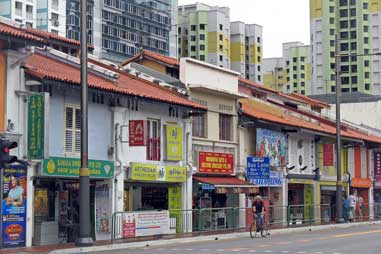 all very civilised. all very civilised.
 Shops along Serangoon Road:
after our memorably exotic curry feast, we walked
through the Tekka market and out into Serangoon Road. This thoroughfare was busy
with traffic and lined with shop-houses (see right) selling fruit and vegetables (Photo
70 - Serangoon Road shop-houses), foodstuffs, gold jewellery, silks, sarees
(Photo
71 - Shops selling silks and sarees) (see left),
and tailors selling made-to measure suits.
Outside the shop-houses, running along the pavement were the classic five-foot
ways, covered colonnaded arcades arching out from the shop fronts. Despite the
quality feel of the displayed rolls of beautiful silks, Sheila could not be
persuaded to be measured for a saree, nor Paul for a 12 hour suit or shirt. A little further along, we turned off into Cuff
Street searching for the Spice Grinder Shop, allegedly one of the last remaining
of such spice shops in Singapore. There were merchants and import-export
enterprises of every kind, some with container lorries parked outside, but along
the length of the whole street, there was no trace of any spice-grinding
emporium; it was, it seemed, no longer. Shops along Serangoon Road:
after our memorably exotic curry feast, we walked
through the Tekka market and out into Serangoon Road. This thoroughfare was busy
with traffic and lined with shop-houses (see right) selling fruit and vegetables (Photo
70 - Serangoon Road shop-houses), foodstuffs, gold jewellery, silks, sarees
(Photo
71 - Shops selling silks and sarees) (see left),
and tailors selling made-to measure suits.
Outside the shop-houses, running along the pavement were the classic five-foot
ways, covered colonnaded arcades arching out from the shop fronts. Despite the
quality feel of the displayed rolls of beautiful silks, Sheila could not be
persuaded to be measured for a saree, nor Paul for a 12 hour suit or shirt. A little further along, we turned off into Cuff
Street searching for the Spice Grinder Shop, allegedly one of the last remaining
of such spice shops in Singapore. There were merchants and import-export
enterprises of every kind, some with container lorries parked outside, but along
the length of the whole street, there was no trace of any spice-grinding
emporium; it was, it seemed, no longer.
Sri Veeramakaliamman Hindu Temple in Serangoon Road: across on the corner of Serangoon Road and Belilios Road, amid the shops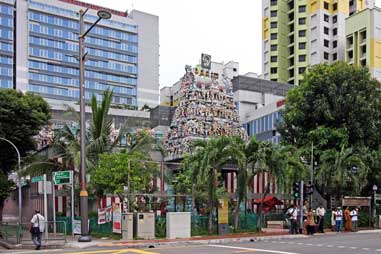 and over towering office
blocks, we found the Sri Veeramakaliamman Temple
(see right) (Photo
72 - Sri Veeramakaliamman Hindu Temple), another of Singapore's
elaborate Hindu shrines, built in 1881 by Bengali immigrants. The
temple was dedicated to Kali, the fiercesome
goddess-consort of the Hindu god Shiva,
and Destroyer of Evil. During the Japanese air raids in WW2, many people sought and over towering office
blocks, we found the Sri Veeramakaliamman Temple
(see right) (Photo
72 - Sri Veeramakaliamman Hindu Temple), another of Singapore's
elaborate Hindu shrines, built in 1881 by Bengali immigrants. The
temple was dedicated to Kali, the fiercesome
goddess-consort of the Hindu god Shiva,
and Destroyer of Evil. During the Japanese air raids in WW2, many people sought
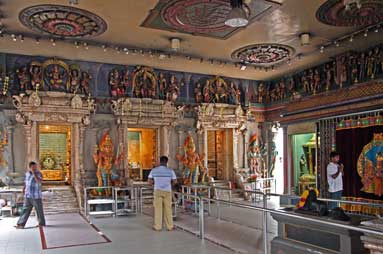 refuge in the temple and prayed for Kali's protection. The goddess kept her
temple and all its statues, along with those seeking shelter, unscathed from the
bombings. In the 1980s, major
reconstruction work took place: a gopuram (entrance tower), ornately
sculptured with idols representing Hindu deities was added along
with eight main domes and several minor ones. refuge in the temple and prayed for Kali's protection. The goddess kept her
temple and all its statues, along with those seeking shelter, unscathed from the
bombings. In the 1980s, major
reconstruction work took place: a gopuram (entrance tower), ornately
sculptured with idols representing Hindu deities was added along
with eight main domes and several minor ones.
Sounding the prayer-bells on the doors in true
Hindu manner as we passed through the gopuram, we removed our shoes to
enter the temple. Around the gloomy interior of the prayer hall, there were more
shrines filled with statues of the Hindu deities
(Photo
73 - Sri Veeramakaliamman prayer hall) (see left), including a few more chubby
little elephant-gods. Ladies in sarees along with their children knelt in prayer
before the shrines, and priests wearing little more than loin clothes attended
the effigies. The rear courtyard was clearly the place where ritual feasts were
held on festival days, and a sign urged devotees 'not to enter the kitchen'.
Large trays of holy bananas had been placed as offerings in front of the shrines
which were decorated with garlands of marigolds, and in a side-street outside the
temple, a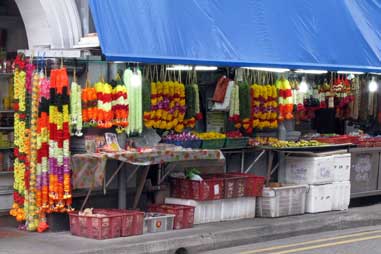 classic Singaporean shop-house stall was selling marigold garlands
(see right) (Photo
74 - Marigold garlands). classic Singaporean shop-house stall was selling marigold garlands
(see right) (Photo
74 - Marigold garlands).
A relaxing moment in an Indian market:
the map showed another temple further down this
side-street; we walked along to investigate, but could find only a small market
area filled with tables alongside a beer stall. A group of very smart and
well-behaved little school
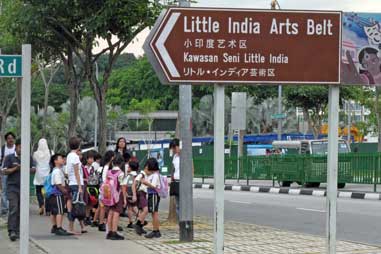 children passed by accompanied by their teachers (see
below left). It was by now gone 5-30pm; the sky had clouded over and the air had
become very heavy, as if one of Singapore's famed tropical storms was brewing.
We were hot and weary, and could see from here one of the entrances to Little
India MRT station just near to the market. So we were close here to the metro in
case shelter were needed. children passed by accompanied by their teachers (see
below left). It was by now gone 5-30pm; the sky had clouded over and the air had
become very heavy, as if one of Singapore's famed tropical storms was brewing.
We were hot and weary, and could see from here one of the entrances to Little
India MRT station just near to the market. So we were close here to the metro in
case shelter were needed.
Rather than returning to Dhoby Ghaut for a final beer before collecting our
packs from the YMCA, we decided to sample the more basic atmosphere of the beer
stall by the market here at Little India to round off our final day. Paul sat with a bottle of Kingfisher
Indian beer from the stall, and chatted with a talkative local gent. Sheila
meanwhile went off to explore other delights, and returned shortly afterwards
carrying what looked like a fairground gold-fish bag, containing a thick, creamy
liquid and straw (Photo
75 - Mango lassi) (see below right); this was a mango lassi, a traditional Indian drink made from
yogurt, milk and mango pulp. The threatened storm held off, but the air was
still heavy and humid. As we sat here drinking our beer and mango lassi, and
relishing our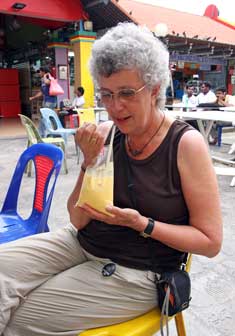 final moments of this wonderful afternoon in the back streets of
Little India, we texted our daughter Lucy in Adelaide to say where we were and
what we were doing. She immediately texted back with severe admonishment for
straying, with such reckless innocence, into what she claimed was such a dubious
area. But looking around us as we sat in the little market thoroughly enjoying
ourselves, it all seemed assuredly safe. It was another case of role reversal,
being told off by our daughter for irresponsible conduct! final moments of this wonderful afternoon in the back streets of
Little India, we texted our daughter Lucy in Adelaide to say where we were and
what we were doing. She immediately texted back with severe admonishment for
straying, with such reckless innocence, into what she claimed was such a dubious
area. But looking around us as we sat in the little market thoroughly enjoying
ourselves, it all seemed assuredly safe. It was another case of role reversal,
being told off by our daughter for irresponsible conduct!
Return to Changi Airport for homeward flight:
but our time enjoying Singapore's market delights
in Little India was rapidly running out; to our regret, it was time to head
back, collect our kit and return to Changi Airport. Past the market shops
displaying all kinds of unknown vegetables such as long thin beans and okra, we
caught the MRT back to Dhoby Ghaut and collected our packs from the YMCA.
Fully laden with our heavy packs, we set off to return to the metro
station amid the crowds of giggling, child-like Singaporean teenagers playing
with their mobile phones. More accustomed now to travelling on the MRT, we boarded the train and secured seats for the 20 minute journey and two changes of train, back out to the airport.
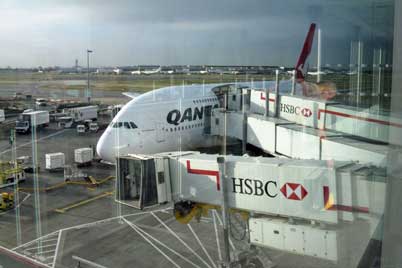 The Skytrain took us from Terminal 2 to Terminal 3
where, after negotiating the escalators, we were able to unload our packs onto a
trolley. We found the tax-reclaim counter where supposedly we could recover the
local tax paid on the polaroid filter bought in the Chinatown market. The system
worked, but we only received back $7, far from the $29 assured by the salesman. We had been well and
truly ripped off! We checked in at the Qantas desk and handed in our packs. It was by now around 8-00pm and we had
well over two hours to sit and relax with a beer. We followed the signs through the
huge airport terminal for the 10 minutes' walk along to Gate 29, the furthest
out where our QF71 flight was billed, but we still had a further hour's wait
until we could pass through the security check to wait at the gate. The Changi security checks were
notoriously and irritatingly officious, but we passed through, reloaded our day sacs and sat
waiting by the gate with the huge crowd of fellow passengers; fortunately the 380 Airbus was
a very commodious plane capable of carrying such numbers (see left). When we were eventually called to
board at 11‑30pm, we found our window seats overlooking the wing. The
3-4-3 seating configuration, with the extra-wide aircraft body and double deck,
seemed to give slightly more lateral space than the Boeing 747. The Skytrain took us from Terminal 2 to Terminal 3
where, after negotiating the escalators, we were able to unload our packs onto a
trolley. We found the tax-reclaim counter where supposedly we could recover the
local tax paid on the polaroid filter bought in the Chinatown market. The system
worked, but we only received back $7, far from the $29 assured by the salesman. We had been well and
truly ripped off! We checked in at the Qantas desk and handed in our packs. It was by now around 8-00pm and we had
well over two hours to sit and relax with a beer. We followed the signs through the
huge airport terminal for the 10 minutes' walk along to Gate 29, the furthest
out where our QF71 flight was billed, but we still had a further hour's wait
until we could pass through the security check to wait at the gate. The Changi security checks were
notoriously and irritatingly officious, but we passed through, reloaded our day sacs and sat
waiting by the gate with the huge crowd of fellow passengers; fortunately the 380 Airbus was
a very commodious plane capable of carrying such numbers (see left). When we were eventually called to
board at 11‑30pm, we found our window seats overlooking the wing. The
3-4-3 seating configuration, with the extra-wide aircraft body and double deck,
seemed to give slightly more lateral space than the Boeing 747.
Overnight flight from Singapore:
the cabin crew on this flight were less
responsive, one downright surly (but she got given the unpleasant job of
cleaning the over-used ablutions!), and the supper meal not nearly so
appetising. We departed Singapore, more or less on time at midnight local time.
Despite being a 13 hour flight, the time zone difference meant only an apparent
6½ hours elapsed clock time; we should therefore land at London Heathrow at just
after 6-30 on Tuesday morning. Again we followed the flight path on the 380
Airbus' more sophisticated video presentation seat-back screen, as the plane
flew over Malaysia, Thailand and across the Bay of Bengal and Northern India. We
put watches on to London time, so being only 4-15 in the afternoon
(seemingly), Paul continued working on yesterday's incomplete log record before
and after supper. Sheila settled down for her overnight sleep, as did most of the
other passengers. Paul's was the only reading light illuminated in the now darkened
cabin by the time he also settled to sleep at 10-00pm (London time).
Across Europe
to London-Heathrow:
we were woken at around 5-00am by the cabin
crew serving a cooked breakfast. By now, overnight we had crossed Afghanistan,
Iraq, and the Caspian Sea, and when we woke, we were crossing Ukraine and
approaching Poland. On the flight plan map satellite view, we could make out
clearly the forests of the Białowieźa National Park on the Eastern Polish
border, and from here the plane flew a direct east~west line over Warsaw and
Poznań. On from there, we followed the same route
 westwards as we had done last
year on our drive across Germany and Holland. Reaching Britain, we flew in along
the Thames estuary, and with minor delays on the approach to Heathrow, we
performed a couple of holding loops over central London, giving a clear view of
the Thames and London Eye landmark. The 380's flight path menu offered a novel
feature of the view from a camera mounted high on the tail fin, giving the
direct forward picture from above down the length of the aircraft. We followed
this spectacular view on the final approach and landing, touching down at
Heathrow at 7‑45am. westwards as we had done last
year on our drive across Germany and Holland. Reaching Britain, we flew in along
the Thames estuary, and with minor delays on the approach to Heathrow, we
performed a couple of holding loops over central London, giving a clear view of
the Thames and London Eye landmark. The 380's flight path menu offered a novel
feature of the view from a camera mounted high on the tail fin, giving the
direct forward picture from above down the length of the aircraft. We followed
this spectacular view on the final approach and landing, touching down at
Heathrow at 7‑45am.
Coach journey home:
we loaded our hand-luggage onto a trolley for the
seemingly endless foot-slog through the Heathrow corridors. It took a while to
clear the lengthy queues at UK immigration desks, then a nerve-wracking delay
waiting for our packs to be off-loaded onto the carousel at baggage-reclaim; had
the system failed us on the final flight? To our relief, we at last spotted our
packs for retrieval, and continued the onward route-march. We were booked on the
7-30am National Express coach from Heathrow to Leicester, but by the time we
reached the central coach station, it was 7-45. The National Express ticket
office staff were most understanding, and booked us onto the next coach leaving
at 9-00am; we therefore had an hour to get a coffee.
There was plenty of space on the coach, but its
scheduled arrival time at Leicester coach station was 11-20, giving just three
minutes to retrieve our packs and stumble across for the 11-23 bus out to our
village. We dozed for most of the two hour journey up the M1, and pulled into
Leicester coach station at 11-15, giving us 5 minutes easily to catch the our
village
bus. Keeping our packs on our shoulders, we each occupied two seats; other elderly
passengers stared at us in bemusement. We finally stepped off the bus by our
village church at 12‑00 noon, from
where we had departed for Oz with our packs seven weeks ago, and we staggered down the hill to home
(see right)
(Photo
76 - Arriving home). Despite being travel weary, we spent a productive
afternoon unloading kit and 'putting Australia to bed'. We now had a very brief
15 day inter-trip interval for all the preparatory jobs before we should set off
again in our own campervan for the Baltic States.
Hong Kong~Australia~Singapore had been a
once-in-a-lifetime trip, with unprecedented experiences and learning; but with the
resumption now of our full summer travelling lifestyle soon after our return,
when the log would be written up and photos edited and added was anyone's guess.
How could anyone believe it would take another nine years and the impact of a
devastating world-wide pandemic before the 2011 Australia and Far East
back-packing trip would be written up and published on our web site.
|
Sheila and Paul |
Published: 3 January 2022 |
|
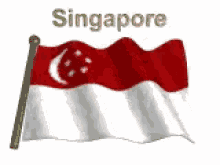
 FAR
EASTERN BACK-PACKING VENTURE 2011 - Singapore stop-over:
FAR
EASTERN BACK-PACKING VENTURE 2011 - Singapore stop-over:
 Our visit to the British military command-post: in the Battle Box
presentation, General Percival's final conference at which, after heated
argument and recrimination the decision was taken to surrender, was simulated
by rather less than convincing automated manikins (Photo
58 - Fort Channing simulation) (see above left and right), and with
even more clumsy sound-effects. Percival became a scapegoat for the necessity to
surrender Singapore, and went into POW captivity along with his troops.
Following the surrender, the Singaporean civilian population, particularly the
Chinese, were subjected to massacres and treated with savage brutality, and many
died in captivity as a result. Many of the British and Commonwealth POWs died in
captivity in Changi prison; many others were shipped to Japan for slave labour
or force-marched to work on building the Siam-Burma Death Railway. Singapore
finally returned to British control after Japanese surrender was enforced by the
dropping of atomic bombs on Hiroshima and Nagasaki in August 1945. Yamashita,
the Japanese commander at the capture of Singapore,
Our visit to the British military command-post: in the Battle Box
presentation, General Percival's final conference at which, after heated
argument and recrimination the decision was taken to surrender, was simulated
by rather less than convincing automated manikins (Photo
58 - Fort Channing simulation) (see above left and right), and with
even more clumsy sound-effects. Percival became a scapegoat for the necessity to
surrender Singapore, and went into POW captivity along with his troops.
Following the surrender, the Singaporean civilian population, particularly the
Chinese, were subjected to massacres and treated with savage brutality, and many
died in captivity as a result. Many of the British and Commonwealth POWs died in
captivity in Changi prison; many others were shipped to Japan for slave labour
or force-marched to work on building the Siam-Burma Death Railway. Singapore
finally returned to British control after Japanese surrender was enforced by the
dropping of atomic bombs on Hiroshima and Nagasaki in August 1945. Yamashita,
the Japanese commander at the capture of Singapore, was tried and convicted by a
US military war crimes commission, and was hanged in the Philippines in
February 1946.
was tried and convicted by a
US military war crimes commission, and was hanged in the Philippines in
February 1946.
 final moments of this wonderful afternoon in the back streets of
Little India, we texted our daughter Lucy in Adelaide to say where we were and
what we were doing. She immediately texted back with severe admonishment for
straying, with such reckless innocence, into what she claimed was such a dubious
area. But looking around us as we sat in the little market thoroughly enjoying
ourselves, it all seemed assuredly safe. It was another case of role reversal,
being told off by our daughter for irresponsible conduct!
final moments of this wonderful afternoon in the back streets of
Little India, we texted our daughter Lucy in Adelaide to say where we were and
what we were doing. She immediately texted back with severe admonishment for
straying, with such reckless innocence, into what she claimed was such a dubious
area. But looking around us as we sat in the little market thoroughly enjoying
ourselves, it all seemed assuredly safe. It was another case of role reversal,
being told off by our daughter for irresponsible conduct! The Skytrain took us from Terminal 2 to Terminal 3
where, after negotiating the escalators, we were able to unload our packs onto a
trolley. We found the tax-reclaim counter where supposedly we could recover the
local tax paid on the polaroid filter bought in the Chinatown market. The system
worked, but we only received back $7, far from the $29 assured by the salesman. We had been well and
truly ripped off! We checked in at the Qantas desk and handed in our packs. It was by now around 8-00pm and we had
well over two hours to sit and relax with a beer. We followed the signs through the
huge airport terminal for the 10 minutes' walk along to Gate 29, the furthest
out where our QF71 flight was billed, but we still had a further hour's wait
until we could pass through the security check to wait at the gate. The Changi security checks were
notoriously and irritatingly officious, but we passed through, reloaded our day sacs and sat
waiting by the gate with the huge crowd of fellow passengers; fortunately the 380 Airbus was
a very commodious plane capable of carrying such numbers (see left). When we were eventually called to
board at 11‑30pm, we found our window seats overlooking the wing. The
3-4-3 seating configuration, with the extra-wide aircraft body and double deck,
seemed to give slightly more lateral space than the Boeing 747.
The Skytrain took us from Terminal 2 to Terminal 3
where, after negotiating the escalators, we were able to unload our packs onto a
trolley. We found the tax-reclaim counter where supposedly we could recover the
local tax paid on the polaroid filter bought in the Chinatown market. The system
worked, but we only received back $7, far from the $29 assured by the salesman. We had been well and
truly ripped off! We checked in at the Qantas desk and handed in our packs. It was by now around 8-00pm and we had
well over two hours to sit and relax with a beer. We followed the signs through the
huge airport terminal for the 10 minutes' walk along to Gate 29, the furthest
out where our QF71 flight was billed, but we still had a further hour's wait
until we could pass through the security check to wait at the gate. The Changi security checks were
notoriously and irritatingly officious, but we passed through, reloaded our day sacs and sat
waiting by the gate with the huge crowd of fellow passengers; fortunately the 380 Airbus was
a very commodious plane capable of carrying such numbers (see left). When we were eventually called to
board at 11‑30pm, we found our window seats overlooking the wing. The
3-4-3 seating configuration, with the extra-wide aircraft body and double deck,
seemed to give slightly more lateral space than the Boeing 747.
 Final morning in Perth:
our final day in Australia, and we were up early to complete packing our kit
ready for today's onward flight to Singapore. We had arranged for the Perth hostel warden
to drive us out to the distant and inaccessible Perth International Airport, for
what seemed an expensive $30; but the journey by bus, the only alternative with all
its uncertainties of timing, would have cost almost as much. We settled
up at the hostel and retrieved our $20 key deposit, and on the drive out to the
airport, it came out in conversation with the warden that he and his wife came originally
from Athens. We did not pursue the detail of how they finished up running a
back-packing hostel in Perth; that seemed a story too far. Saturday morning traffic on was light, and we were dropped at the airport forecourt at 9-15am
(
Final morning in Perth:
our final day in Australia, and we were up early to complete packing our kit
ready for today's onward flight to Singapore. We had arranged for the Perth hostel warden
to drive us out to the distant and inaccessible Perth International Airport, for
what seemed an expensive $30; but the journey by bus, the only alternative with all
its uncertainties of timing, would have cost almost as much. We settled
up at the hostel and retrieved our $20 key deposit, and on the drive out to the
airport, it came out in conversation with the warden that he and his wife came originally
from Athens. We did not pursue the detail of how they finished up running a
back-packing hostel in Perth; that seemed a story too far. Saturday morning traffic on was light, and we were dropped at the airport forecourt at 9-15am
( few moments in the lounge area by the gate overlooking
the Qantas Airbus 330 waiting below
(see left) (
few moments in the lounge area by the gate overlooking
the Qantas Airbus 330 waiting below
(see left) (
 Our first evening in Singapore:
having recovered a little and
cleaned up, we went out to try and find some supper. The receptionist pointed us
in the direction of a food court across the way in the main Bras Basah Road. Our
outline map suggested we should cross an intervening open green space labelled as
Bras Basah Park, but in the meantime some oriental developer had inconveniently filled the open space with a sky-scraper. Weaving our way over, we somehow found the classic Asiatic food hall, and even better next door was an
'Irish pub'. Utterly indifferent to the noise of TVs blaring out an English
football match, we ordered pints of Singapore Tiger beer, and sat obediently
at the bar where the bar girls had escorted us to seats. Revelling in the
refreshing taste
of our beers, we watched in fascination as the barman busily mixed cocktails;
whether they were Irish or not, we did not bother to ask. The beer was expensive, but so welcome after the traumas of our journey in from Changi
Airport. Next door in the food hall, we toured the stalls and ordered bowls of who-knows-what
from a Vietnamese stall. But it tasted delicious, and so hungry
were we that Sheila had a further bowl of oriental ice cream while Paul tucked into a
plate of curry from an Indian stall.
Our first evening in Singapore:
having recovered a little and
cleaned up, we went out to try and find some supper. The receptionist pointed us
in the direction of a food court across the way in the main Bras Basah Road. Our
outline map suggested we should cross an intervening open green space labelled as
Bras Basah Park, but in the meantime some oriental developer had inconveniently filled the open space with a sky-scraper. Weaving our way over, we somehow found the classic Asiatic food hall, and even better next door was an
'Irish pub'. Utterly indifferent to the noise of TVs blaring out an English
football match, we ordered pints of Singapore Tiger beer, and sat obediently
at the bar where the bar girls had escorted us to seats. Revelling in the
refreshing taste
of our beers, we watched in fascination as the barman busily mixed cocktails;
whether they were Irish or not, we did not bother to ask. The beer was expensive, but so welcome after the traumas of our journey in from Changi
Airport. Next door in the food hall, we toured the stalls and ordered bowls of who-knows-what
from a Vietnamese stall. But it tasted delicious, and so hungry
were we that Sheila had a further bowl of oriental ice cream while Paul tucked into a
plate of curry from an Indian stall. Returning to the YMCA amid the
crowds of laughing, child-like Singaporean Eloi, we fell into the ultra luxury
of our 'suite'. After the
Returning to the YMCA amid the
crowds of laughing, child-like Singaporean Eloi, we fell into the ultra luxury
of our 'suite'. After the
 primitive state of the Perth back-packing hostel, such comfort,
albeit at expensive prices, was so welcome. And we slept the sleep of the righteous in this air-conditioned splendour.
primitive state of the Perth back-packing hostel, such comfort,
albeit at expensive prices, was so welcome. And we slept the sleep of the righteous in this air-conditioned splendour. Bridge Road with its English-style red double-decker buses, palm
trees and more street-gardens (see left) (
Bridge Road with its English-style red double-decker buses, palm
trees and more street-gardens (see left) ( the
far embankment, the brightly painted frontages of former shop-houses and
go-downs
(warehouses), now restored as river-side restaurants, created a contrasting
colourful foreground
(
the
far embankment, the brightly painted frontages of former shop-houses and
go-downs
(warehouses), now restored as river-side restaurants, created a contrasting
colourful foreground
( Town Plan for Singapore to make fullest use of limited land in the new settlement.
Raffles specified the uniformity and regularity of buildings, the materials to be used
as well as features of the buildings such as a covered passageway. Over the
decades after the colonial era, entire blocks of historical shop-houses in the
urban centre were demolished for
high-density, high-rise developments or
governmental facilities. But many of the traditional shop-houses have now been
restored as colourful, tourist-oriented
Town Plan for Singapore to make fullest use of limited land in the new settlement.
Raffles specified the uniformity and regularity of buildings, the materials to be used
as well as features of the buildings such as a covered passageway. Over the
decades after the colonial era, entire blocks of historical shop-houses in the
urban centre were demolished for
high-density, high-rise developments or
governmental facilities. But many of the traditional shop-houses have now been
restored as colourful, tourist-oriented  restaurants, particularly along the
river-front quays (
restaurants, particularly along the
river-front quays ( Outline history of Singapore:
between the 16th and 19th centuries, the Malay Archipelago was gradually
colonised by the European powers, beginning with the settlement by the
Portuguese at Malacca in 1509. The early dominance of the Portuguese was
challenged during the 17th century by the Dutch, who controlled
most of the ports in the region and established a monopoly over trade within the
archipelago, particularly in spices, then the region's most important product.
In 1818, British East India Company colonial administrator Sir Stamford Raffles
(see right) was appointed Lieutenant Governor of the colony at Bencoolen on the SW coast of
Sumatra. The Dutch had been stifling British trade in the region by prohibiting
the British from operating in Dutch-controlled ports or by subjecting them to
high tariffs. Determined to increase British power and trading influence in the
Archipelago, Raffles' plan was to challenge the Dutch monopoly by establishing a
new and free trading post along the Straits of Malacca at Singapore Island off the
southern tip of the Malay peninsula. Raffles selected this position as a strategic cross-roads on the trading
routes of SE Asia, with Malay, Indian and Chinese merchants plying the shipping
lanes of the Straits of Malacca at the confluence of the Indian and Pacific
Oceans. He persuaded Lord Hastings, Governor-General of India and his
British East India Company superior, to fund an expedition to establish a new
British trading base in the region.
Outline history of Singapore:
between the 16th and 19th centuries, the Malay Archipelago was gradually
colonised by the European powers, beginning with the settlement by the
Portuguese at Malacca in 1509. The early dominance of the Portuguese was
challenged during the 17th century by the Dutch, who controlled
most of the ports in the region and established a monopoly over trade within the
archipelago, particularly in spices, then the region's most important product.
In 1818, British East India Company colonial administrator Sir Stamford Raffles
(see right) was appointed Lieutenant Governor of the colony at Bencoolen on the SW coast of
Sumatra. The Dutch had been stifling British trade in the region by prohibiting
the British from operating in Dutch-controlled ports or by subjecting them to
high tariffs. Determined to increase British power and trading influence in the
Archipelago, Raffles' plan was to challenge the Dutch monopoly by establishing a
new and free trading post along the Straits of Malacca at Singapore Island off the
southern tip of the Malay peninsula. Raffles selected this position as a strategic cross-roads on the trading
routes of SE Asia, with Malay, Indian and Chinese merchants plying the shipping
lanes of the Straits of Malacca at the confluence of the Indian and Pacific
Oceans. He persuaded Lord Hastings, Governor-General of India and his
British East India Company superior, to fund an expedition to establish a new
British trading base in the region. the Port of Singapore
harbour facilities. There was also a severe shortage of food leading to malnutrition,
disease, and rampant crime and violence. High food prices, unemployment, and
workers' discontent culminated in a series of strikes in 1947, causing massive
stoppages in public transport and other services. Britain's failure successfully
to defend Singapore in 1942 had destroyed its credibility as a ruler in the eyes
of Singaporeans, and led to increasing pressure for Singapore's political autonomy.
the Port of Singapore
harbour facilities. There was also a severe shortage of food leading to malnutrition,
disease, and rampant crime and violence. High food prices, unemployment, and
workers' discontent culminated in a series of strikes in 1947, causing massive
stoppages in public transport and other services. Britain's failure successfully
to defend Singapore in 1942 had destroyed its credibility as a ruler in the eyes
of Singaporeans, and led to increasing pressure for Singapore's political autonomy. joining
the United Nations. Singapore was ruled by Lee Kuan Yew until 1990. His
authoritarian-liberal regime, with its emphasis on rapid economic growth,
support for business entrepreneurship, and limitations on internal democracy,
shaped Singapore's policies for the next half-century. The island-state progressed as
a centre for trade and finance to become one of the original
four Asian Tiger economies (along with Hong Kong, South Korea,
and Taiwan), attracting international financial
institutions to establish their HQs
in Singapore.
The Port of Singapore with its extended entrepôt trade
emerged as a key transportation and logistics hub, becoming one of the world's
busiest ports along with the service and tourism industries, also growing
immensely during this period.
joining
the United Nations. Singapore was ruled by Lee Kuan Yew until 1990. His
authoritarian-liberal regime, with its emphasis on rapid economic growth,
support for business entrepreneurship, and limitations on internal democracy,
shaped Singapore's policies for the next half-century. The island-state progressed as
a centre for trade and finance to become one of the original
four Asian Tiger economies (along with Hong Kong, South Korea,
and Taiwan), attracting international financial
institutions to establish their HQs
in Singapore.
The Port of Singapore with its extended entrepôt trade
emerged as a key transportation and logistics hub, becoming one of the world's
busiest ports along with the service and tourism industries, also growing
immensely during this period. Raffles Quay and Landing Stage:
and here we stood on the embankment at Raffles Landing Place, where the jungle island
village cum colonial trading post cum world-Class port and finance capital had
all begun just under 200 years ago.
At the far end of the quay, the white marble statue of Sir Stamford Raffles (see
above left) (
Raffles Quay and Landing Stage:
and here we stood on the embankment at Raffles Landing Place, where the jungle island
village cum colonial trading post cum world-Class port and finance capital had
all begun just under 200 years ago.
At the far end of the quay, the white marble statue of Sir Stamford Raffles (see
above left) ( 1819 and concluded the first treaty with the local rulers. The plaque on
the statue at the landing site commemorating this first landing in Singapore,
records that With genius and perception, Raffles changed the destiny of
Singapore from an obscure fishing village to a great seaport and modern
metropolis. How would Raffles have reacted if he could
now see what the small trading settlement he had founded in 1819 had developed
into? Imperialist that he was, he would probably have been unsurprised at how
far his colony had progressed from its humble beginnings. Having photographed His Statue against the backdrop of Raffles Place
Central Business District sky-scrapers, we booked our places on the bum-boat
cruise along the Singapore River.
1819 and concluded the first treaty with the local rulers. The plaque on
the statue at the landing site commemorating this first landing in Singapore,
records that With genius and perception, Raffles changed the destiny of
Singapore from an obscure fishing village to a great seaport and modern
metropolis. How would Raffles have reacted if he could
now see what the small trading settlement he had founded in 1819 had developed
into? Imperialist that he was, he would probably have been unsurprised at how
far his colony had progressed from its humble beginnings. Having photographed His Statue against the backdrop of Raffles Place
Central Business District sky-scrapers, we booked our places on the bum-boat
cruise along the Singapore River.  Cruise along the Singapore River:
to begin with, we had the open-sided boat almost to ourselves (see above right), and were able to move freely from side to side, photographing the
buildings, sky-line and bridges as we passed. The morning light was glorious,
and we took full advantage of all the photographic opportunities. The
sky-scrapers of the Raffles Place Central Business District towered overhead
(
Cruise along the Singapore River:
to begin with, we had the open-sided boat almost to ourselves (see above right), and were able to move freely from side to side, photographing the
buildings, sky-line and bridges as we passed. The morning light was glorious,
and we took full advantage of all the photographic opportunities. The
sky-scrapers of the Raffles Place Central Business District towered overhead
( by convict labour. It was built
to connect the colonial administrative district on the north bank directly with
the developing commercial district on the southern side, replacing a detour via
a neighbouring bridge or a boat crossing. Beyond the Fullerton Hotel, we pulled
into a quay on the southern bank (see above right) (
by convict labour. It was built
to connect the colonial administrative district on the north bank directly with
the developing commercial district on the southern side, replacing a detour via
a neighbouring bridge or a boat crossing. Beyond the Fullerton Hotel, we pulled
into a quay on the southern bank (see above right) ( into the wide
area of water of Marina Bay which was over-towered on the southern side by further
distinctive office-block skyscrapers (
into the wide
area of water of Marina Bay which was over-towered on the southern side by further
distinctive office-block skyscrapers (
 two roads leading to it were accordingly named
North Bridge Road and South Bridge Road.
With the foundation of the colony in 1819, Raffles issued an instruction that a
bridge be built as soon as possible across the Singapore River to link the town planned for the
Chinese community on the southern side of the river to another intended for the
Malays on the northern side. In 1822, a wooden footbridge was
built, and was replaced by a further wooden bridge in 1844. This was demolished
in 1862 and in its place an iron bridge
was built and named Elgin Bridge after the Governor General of
India, Earl Elgin; this was replaced in 1929 by the present
single-arch concrete box-girder bridge, which still connects the Chinese and Indian quarters of the city.
Beyond further bridges (see left) (
two roads leading to it were accordingly named
North Bridge Road and South Bridge Road.
With the foundation of the colony in 1819, Raffles issued an instruction that a
bridge be built as soon as possible across the Singapore River to link the town planned for the
Chinese community on the southern side of the river to another intended for the
Malays on the northern side. In 1822, a wooden footbridge was
built, and was replaced by a further wooden bridge in 1844. This was demolished
in 1862 and in its place an iron bridge
was built and named Elgin Bridge after the Governor General of
India, Earl Elgin; this was replaced in 1929 by the present
single-arch concrete box-girder bridge, which still connects the Chinese and Indian quarters of the city.
Beyond further bridges (see left) ( to walk back along the
tree-shaded north embankment (
to walk back along the
tree-shaded north embankment ( A much-needed drink
at river-side restaurant: as we crossed Elgin Bridge to the southern
embankment, further photogenic views opened up of the Singapore Parliament building
(
A much-needed drink
at river-side restaurant: as we crossed Elgin Bridge to the southern
embankment, further photogenic views opened up of the Singapore Parliament building
( ocean-liner
profile of the Marina Bay Sands topping its three towers stood majestically
above surrounding buildings. This riverside prospect through the red paper
lanterns decorating the restaurant terrace (
ocean-liner
profile of the Marina Bay Sands topping its three towers stood majestically
above surrounding buildings. This riverside prospect through the red paper
lanterns decorating the restaurant terrace ( Jamae Mosque in Chinatown district along South Bridge Road:
back up at the bridge, we turned south along South Bridge Road, a rather mundane street along this stretch;
the little traffic on a Sunday afternoon
included a cycling municipal street cleaner (
Jamae Mosque in Chinatown district along South Bridge Road:
back up at the bridge, we turned south along South Bridge Road, a rather mundane street along this stretch;
the little traffic on a Sunday afternoon
included a cycling municipal street cleaner ( architectural style, borrowing elements from both East and
West, which reflects the architectural styles of 1830s Singapore. The present
structure remains virtually unchanged since its foundation: worshippers enter
the mosque through a gateway framed by two minarets topped by onion domes
and a miniature palace façade based on South Indian Indo-Islamic influence. The mosque's compound with covered
foyer leads to the two prayer halls and shrine which in contrast are
Neo-Classical in style with Doric columns and large windows with Chinese green-glazed tiles.
architectural style, borrowing elements from both East and
West, which reflects the architectural styles of 1830s Singapore. The present
structure remains virtually unchanged since its foundation: worshippers enter
the mosque through a gateway framed by two minarets topped by onion domes
and a miniature palace façade based on South Indian Indo-Islamic influence. The mosque's compound with covered
foyer leads to the two prayer halls and shrine which in contrast are
Neo-Classical in style with Doric columns and large windows with Chinese green-glazed tiles. believers in the benign attributes of the Muslim
faith. He insisted that other peoples' gods were welcome in the apparently
exclusive pantheon of Allah and Muhammad,
albeit with bit-parts; clearly believing we were Catholics, he even stressed
there was a place for the Virgin Mary, providing of course that Jesus owned up
to his deceit and admitted that he was not the Son of God! With our agnostic
leanings, somehow we were not
persuaded by such condescending bigotry, particularly given the seemingly world-wide
ultra-extremist ranting and terror inspired by Islam. So changing the subject,
Paul countered by asking if young people came to the mosque to be taught the
ways of peace and understanding; of course, the iman replied. Paul was sufficiently tactful to avoid a supplemental
question as to whether terrorism was also on their curriculum; we made a
tactical withdrawal to retrieve our shoes, and move on.
believers in the benign attributes of the Muslim
faith. He insisted that other peoples' gods were welcome in the apparently
exclusive pantheon of Allah and Muhammad,
albeit with bit-parts; clearly believing we were Catholics, he even stressed
there was a place for the Virgin Mary, providing of course that Jesus owned up
to his deceit and admitted that he was not the Son of God! With our agnostic
leanings, somehow we were not
persuaded by such condescending bigotry, particularly given the seemingly world-wide
ultra-extremist ranting and terror inspired by Islam. So changing the subject,
Paul countered by asking if young people came to the mosque to be taught the
ways of peace and understanding; of course, the iman replied. Paul was sufficiently tactful to avoid a supplemental
question as to whether terrorism was also on their curriculum; we made a
tactical withdrawal to retrieve our shoes, and move on. Sri Mariamann Hindu Temple:
on the next corner, between the again appropriately named side-streets of Pagoda Street and Temple Street, we
reached the highly ornate Sri Mariamann Hindu Temple. This was
Singapore's oldest and most important Hindu temple, serving the majority
Hindu Tamil Singaporeans. It was founded in 1827 by Naraina Pillai, eight
years after the trading settlement's establishment. Pillai was a government
clerk from Penang who arrived in Singapore with Raffles 1819; he went on
to set up the island's first construction
company, and was also involved in the textile trade; rapidly
Sri Mariamann Hindu Temple:
on the next corner, between the again appropriately named side-streets of Pagoda Street and Temple Street, we
reached the highly ornate Sri Mariamann Hindu Temple. This was
Singapore's oldest and most important Hindu temple, serving the majority
Hindu Tamil Singaporeans. It was founded in 1827 by Naraina Pillai, eight
years after the trading settlement's establishment. Pillai was a government
clerk from Penang who arrived in Singapore with Raffles 1819; he went on
to set up the island's first construction
company, and was also involved in the textile trade; rapidly
 establishing himself
in business, he was identified as a leader of the Indian community. The wealth
and importance of Sri Mariamann Temple was evident from the highly ornate
monumental pagoda-like tower (gopuram) over the entranceway (see above
left) (
establishing himself
in business, he was identified as a leader of the Indian community. The wealth
and importance of Sri Mariamann Temple was evident from the highly ornate
monumental pagoda-like tower (gopuram) over the entranceway (see above
left) ( the rural areas of
Tamil Nadu in Southern India. The prayer hall
was surrounded by a series of free-standing shrines, housed in pavilion-like
structures with decorated domed roofs (see above right) (
the rural areas of
Tamil Nadu in Southern India. The prayer hall
was surrounded by a series of free-standing shrines, housed in pavilion-like
structures with decorated domed roofs (see above right) ( Again with some hesitation, we removed our shoes to enter the temple courtyard. A service
(if that was the correct term for Hindu devotions) had clearly just
finished,
and ladies in sarees were standing waiting to be collected. Inside the prayer
hall was the inner sanctum with Mariamman's shrine, surrounded by open
courtyards in which the smaller shrines were set. Statue-filled niches
surrounded the hall, and the ceilings were richly decorated with portraits of
the Hindu deities; the domed roofs of the smaller shrines
were covered with images of Hindu holy figures.
The intriguing feature of the Hindu religion was the fascinating range and appearance of its
deities
(
Again with some hesitation, we removed our shoes to enter the temple courtyard. A service
(if that was the correct term for Hindu devotions) had clearly just
finished,
and ladies in sarees were standing waiting to be collected. Inside the prayer
hall was the inner sanctum with Mariamman's shrine, surrounded by open
courtyards in which the smaller shrines were set. Statue-filled niches
surrounded the hall, and the ceilings were richly decorated with portraits of
the Hindu deities; the domed roofs of the smaller shrines
were covered with images of Hindu holy figures.
The intriguing feature of the Hindu religion was the fascinating range and appearance of its
deities
( Singapore's remarkable mingling of ethnic and religious communities.
Singapore's remarkable mingling of ethnic and religious communities. camera, Paul was an obvious
target for the touts, and in a moment of weakness, allowed himself to be drawn
into one of the photographic shops. The salesman was a skilful
operator: he tried to sell us a supplemental lens for the camera, insisting on
fitting one to the camera body and bringing the price down further and further.
We were trapped and nothing that Paul could do, without forthright rudeness and
walking out, would have extricated us. We finally, and with great difficulty,
managed to undo the lens on offer and retrieve the camera body, but the salesman was not
letting us go that easily. What about a Polaroid filter? Paul again made the fatal error of showing momentary interest.
Again the price came down and down, and we finally agreed a price. But when the bill came, it was
far in excess of
camera, Paul was an obvious
target for the touts, and in a moment of weakness, allowed himself to be drawn
into one of the photographic shops. The salesman was a skilful
operator: he tried to sell us a supplemental lens for the camera, insisting on
fitting one to the camera body and bringing the price down further and further.
We were trapped and nothing that Paul could do, without forthright rudeness and
walking out, would have extricated us. We finally, and with great difficulty,
managed to undo the lens on offer and retrieve the camera body, but the salesman was not
letting us go that easily. What about a Polaroid filter? Paul again made the fatal error of showing momentary interest.
Again the price came down and down, and we finally agreed a price. But when the bill came, it was
far in excess of the agreed sum. You can
reclaim the tax at the airport, he claimed; I'll supply the paperwork. But even
knocking off the tax, at two Singapore dollars to the pound, it was
far more than the agreed figure. Too numb to argue, we gullibly gave in; we were
well and truly hooked. Paul had his birthday present, but at what price!
the agreed sum. You can
reclaim the tax at the airport, he claimed; I'll supply the paperwork. But even
knocking off the tax, at two Singapore dollars to the pound, it was
far more than the agreed figure. Too numb to argue, we gullibly gave in; we were
well and truly hooked. Paul had his birthday present, but at what price! specialty
made up of a pile of crushed ice and ice cream with jelly pieces, fruits, berries, sweet corn
and red beans, all topped with mango sauce. It was deliciously refreshing.
specialty
made up of a pile of crushed ice and ice cream with jelly pieces, fruits, berries, sweet corn
and red beans, all topped with mango sauce. It was deliciously refreshing. map as the Buddha Tooth Relic Temple. The temple
was designed by the Chief Abbot Venerable Shi Fa Zhao in traditional Tang
Dynasty architectural style, and was built in 2007 to house the eponymous left
canine tooth relic of Buddha, which had been recovered from his funeral pyre in Kushinagar, India. The Buddha Tooth Relic is housed in a giant
stupa, a
dome-shaped structure for containing relics, weighing 3,500 kilograms and made from
320kgs of gold, mostly donated by Buddhist devotees. As well as housing
this scared relic, the temple also serves as a Buddhist cultural and educational
centre promoting the legacy of Buddha's teachings. The exterior of
this huge multi-galleried Buddhist temple was draped with pink paper blossom (
map as the Buddha Tooth Relic Temple. The temple
was designed by the Chief Abbot Venerable Shi Fa Zhao in traditional Tang
Dynasty architectural style, and was built in 2007 to house the eponymous left
canine tooth relic of Buddha, which had been recovered from his funeral pyre in Kushinagar, India. The Buddha Tooth Relic is housed in a giant
stupa, a
dome-shaped structure for containing relics, weighing 3,500 kilograms and made from
320kgs of gold, mostly donated by Buddhist devotees. As well as housing
this scared relic, the temple also serves as a Buddhist cultural and educational
centre promoting the legacy of Buddha's teachings. The exterior of
this huge multi-galleried Buddhist temple was draped with pink paper blossom ( Chinatown Complex Food Centre and the dreaded Durians, King of Fruits:
just behind the Buddhist temple, we found the huge indoor market of the Chinatown
Complex Food Centre. With curiosity renewed, we entered this wholly functional
complex of food stalls, and one of our first encounters helped to clear up an
aspect of Singaporean daily life that had been puzzling us: this morning in the lift lobby on
our floor at the YMCA, below a sign forbidding smoking in the hotel, was a sign
forbidding the presence of Durians alongside a symbol resembling a crossed-out
spiky entity from a space
Chinatown Complex Food Centre and the dreaded Durians, King of Fruits:
just behind the Buddhist temple, we found the huge indoor market of the Chinatown
Complex Food Centre. With curiosity renewed, we entered this wholly functional
complex of food stalls, and one of our first encounters helped to clear up an
aspect of Singaporean daily life that had been puzzling us: this morning in the lift lobby on
our floor at the YMCA, below a sign forbidding smoking in the hotel, was a sign
forbidding the presence of Durians alongside a symbol resembling a crossed-out
spiky entity from a space invaders game (see above right). We had seen the same
sign and symbol on the MRT. But what did this mysterious sign mean? Here in the
Chinatown Complex Food Centre we found
the answer. Tucked away in an obscure corner of the indoor
market, a stall was piled high with green, spiky,
rugby ball-sized fruits, which the signs proclaimed as Durians, the King of Fruits (
invaders game (see above right). We had seen the same
sign and symbol on the MRT. But what did this mysterious sign mean? Here in the
Chinatown Complex Food Centre we found
the answer. Tucked away in an obscure corner of the indoor
market, a stall was piled high with green, spiky,
rugby ball-sized fruits, which the signs proclaimed as Durians, the King of Fruits ( A final tour of the Chinatown Market stalls:
we walked around the functional stalls of hardware, bric-a-brac, and Bollywood DVDs, and
stalls of meat and vegetable. Here Paul found a small snack of curried
pasty to keep him going. Along Sago Street, we found another curiosity:
we had earlier seen youngsters sucking drinks through straws from large green fruit shells. At
a stall here, we discovered that these were unripe green coconuts; the top was
cut away and the inside partially scooped out, leaving the juice and fleshy
fruit. We had to try this. The stall lady was very obliging and brought us
2 straws, and we took it in turn sucking out the sweet,
refreshing coconut milk (
A final tour of the Chinatown Market stalls:
we walked around the functional stalls of hardware, bric-a-brac, and Bollywood DVDs, and
stalls of meat and vegetable. Here Paul found a small snack of curried
pasty to keep him going. Along Sago Street, we found another curiosity:
we had earlier seen youngsters sucking drinks through straws from large green fruit shells. At
a stall here, we discovered that these were unripe green coconuts; the top was
cut away and the inside partially scooped out, leaving the juice and fleshy
fruit. We had to try this. The stall lady was very obliging and brought us
2 straws, and we took it in turn sucking out the sweet,
refreshing coconut milk ( half hour earlier.
half hour earlier.  Taoist shrine-temple of Thian Hock Keng:
at the corner where we emerged into Telok Ayer Street, we reached the Taoist
shrine-temple of Thian Hock Keng,
meaning Palace of Heavenly Happiness (see above right). This was the oldest and most important
temple in Singapore, built to serve the local Hokkien community of immigrants
from Southern China and dedicated to Matsu, Goddess
of the Sea, Queen of Heaven and Patroness of Sailors. The temple is now located
on Telok Ayer Street, but before land reclamation
Taoist shrine-temple of Thian Hock Keng:
at the corner where we emerged into Telok Ayer Street, we reached the Taoist
shrine-temple of Thian Hock Keng,
meaning Palace of Heavenly Happiness (see above right). This was the oldest and most important
temple in Singapore, built to serve the local Hokkien community of immigrants
from Southern China and dedicated to Matsu, Goddess
of the Sea, Queen of Heaven and Patroness of Sailors. The temple is now located
on Telok Ayer Street, but before land reclamation work began in the 1880s, this area used
on the waterfront. When originally built in the 1820s, the Thian Hock Keng Temple faced the sea, where seafarers and immigrants could give thanks to the
sea goddess for a safe sea passage on their arrival at Singapore. Building
materials for the temple and a statue of Matsu were brought over from China, and
the statue enshrined in the main hall of the temple in 1840. The exterior of the
temple, originally decorated with carved wooden dragons, was now unfortunately
beginning to succumb to dereliction; it was today all locked up and badly in
need of renovation.
work began in the 1880s, this area used
on the waterfront. When originally built in the 1820s, the Thian Hock Keng Temple faced the sea, where seafarers and immigrants could give thanks to the
sea goddess for a safe sea passage on their arrival at Singapore. Building
materials for the temple and a statue of Matsu were brought over from China, and
the statue enshrined in the main hall of the temple in 1840. The exterior of the
temple, originally decorated with carved wooden dragons, was now unfortunately
beginning to succumb to dereliction; it was today all locked up and badly in
need of renovation. else of the many culinary
traditions represented in Singapore. All of this was familiar from last
evening's food-hall experience. What
else of the many culinary
traditions represented in Singapore. All of this was familiar from last
evening's food-hall experience. What was however new for us were the archetypally Singaporean satay stalls, set out in the outdoor seating area of
Boon Tat Street alongside the covered market.
was however new for us were the archetypally Singaporean satay stalls, set out in the outdoor seating area of
Boon Tat Street alongside the covered market. We firstly selected a stall selling grilled
tiger prawns, and ordered two each with a plate of vermicelli noodles. The
prawns were very messy to shell, but unbelievably
delicious with their thick,
meaty and really tasty flesh. Having cleared our dish of noodles, we moved onto
our second course: at another stall we ordered ten satay kebabs with their
accompanying little dishes of spicy
peanut sauce
(
We firstly selected a stall selling grilled
tiger prawns, and ordered two each with a plate of vermicelli noodles. The
prawns were very messy to shell, but unbelievably
delicious with their thick,
meaty and really tasty flesh. Having cleared our dish of noodles, we moved onto
our second course: at another stall we ordered ten satay kebabs with their
accompanying little dishes of spicy
peanut sauce
( It was a totally exhilarating
experience, enjoying a wonderfully traditional Singaporean supper amid the
absorbing atmosphere of the satay stalls and food market (
It was a totally exhilarating
experience, enjoying a wonderfully traditional Singaporean supper amid the
absorbing atmosphere of the satay stalls and food market (
 the YMCA's secure luggage store for
the day, to collect early this evening before leaving for the airport and our
homeward overnight flight.
the YMCA's secure luggage store for
the day, to collect early this evening before leaving for the airport and our
homeward overnight flight. The
Battle Box as Combined Operations Headquarters has been preserved in the state
of 1942 with audio-visual presentations telling the story of events leading up to
the surrender. As we arrived, a group tour was about to begin which we joined as
the young guide issued headphones, with simulated bomb explosions echoing around the underground bunker.
The
Battle Box as Combined Operations Headquarters has been preserved in the state
of 1942 with audio-visual presentations telling the story of events leading up to
the surrender. As we arrived, a group tour was about to begin which we joined as
the young guide issued headphones, with simulated bomb explosions echoing around the underground bunker. the sea; the battle-cruisers
Repulse
and Prince of Wales had already been sunk on their way to Singapore by Japanese air attack
in December 1941. But the Japanese failed to oblige British expectations: their
armies poured irresistibly down the Malayan peninsular from Thailand, taking the
British by surprise to threaten Singapore from the landward side. The heavy
naval guns designed to defend Singapore against Japanese naval attack were
equipped with armour-piercing rather than high-explosive shells, and were almost
useless to repel Japanese troops invading from the north. Japanese forces
crossed the Johor Straits to invade the island of Singapore, and within a week the battle
for Singapore was over, resulting in a humiliating British defeat and surrender.
British and Commonwealth troops suffered heavy losses in the fighting and 1000s
were taken prisoner. Churchill called it the worst disaster and largest
capitulation in British history.
the sea; the battle-cruisers
Repulse
and Prince of Wales had already been sunk on their way to Singapore by Japanese air attack
in December 1941. But the Japanese failed to oblige British expectations: their
armies poured irresistibly down the Malayan peninsular from Thailand, taking the
British by surprise to threaten Singapore from the landward side. The heavy
naval guns designed to defend Singapore against Japanese naval attack were
equipped with armour-piercing rather than high-explosive shells, and were almost
useless to repel Japanese troops invading from the north. Japanese forces
crossed the Johor Straits to invade the island of Singapore, and within a week the battle
for Singapore was over, resulting in a humiliating British defeat and surrender.
British and Commonwealth troops suffered heavy losses in the fighting and 1000s
were taken prisoner. Churchill called it the worst disaster and largest
capitulation in British history. Cricket Club founded in 1852; more infamously in 1942, it was used by the Japanese
military as the place where the entire European population was rounded up for
interrogation. It was still a sports ground, but now seemed a bizarrely
anachronistic hangover from British colonial days. The skyline above the sports
field was today dominated by the three towers of the ocean liner deck-topped
Marina Bay Sands Resort (
Cricket Club founded in 1852; more infamously in 1942, it was used by the Japanese
military as the place where the entire European population was rounded up for
interrogation. It was still a sports ground, but now seemed a bizarrely
anachronistic hangover from British colonial days. The skyline above the sports
field was today dominated by the three towers of the ocean liner deck-topped
Marina Bay Sands Resort ( Taking
Tiffin at the Raffles Hotel:
wilting in the hot sun, we walked
along St Andrew's Road and crossed the busy main road to visit the world famous
luxury Raffles Hotel, the emblematic symbol of British colonial rule in
Singapore (see right). Despite the implications of its name, the hotel was in fact
founded, not by Raffles himself, but in1887 by enterprising Armenian hoteliers,
the Sarkies brothers. Over the years, the rich and famous have stayed at the
Raffles Hotel, so we felt it appropriate that we also should take Tiffin there.
Taking
Tiffin at the Raffles Hotel:
wilting in the hot sun, we walked
along St Andrew's Road and crossed the busy main road to visit the world famous
luxury Raffles Hotel, the emblematic symbol of British colonial rule in
Singapore (see right). Despite the implications of its name, the hotel was in fact
founded, not by Raffles himself, but in1887 by enterprising Armenian hoteliers,
the Sarkies brothers. Over the years, the rich and famous have stayed at the
Raffles Hotel, so we felt it appropriate that we also should take Tiffin there. in our hot and busy day, an occasion duly recorded on photograph
(
in our hot and busy day, an occasion duly recorded on photograph
( The Raffles Museum:
having taken photos of the uniformed commissionaire on guard at the main entrance
(see right) (
The Raffles Museum:
having taken photos of the uniformed commissionaire on guard at the main entrance
(see right) ( originally the
division of colonial Singapore where, under the Raffles Plan of Singapore,
ethnic Indian immigrants would reside under the British policy of ethnic
segregation. Hindus and Tamil Muslims still make up the majority of the
population in what is now Singapore's most colourful downtown district.
originally the
division of colonial Singapore where, under the Raffles Plan of Singapore,
ethnic Indian immigrants would reside under the British policy of ethnic
segregation. Hindus and Tamil Muslims still make up the majority of the
population in what is now Singapore's most colourful downtown district.
 all very civilised.
all very civilised. Shops along Serangoon Road:
after our memorably exotic curry feast, we walked
through the Tekka market and out into Serangoon Road. This thoroughfare was busy
with traffic and lined with shop-houses (see right) selling fruit and vegetables (
Shops along Serangoon Road:
after our memorably exotic curry feast, we walked
through the Tekka market and out into Serangoon Road. This thoroughfare was busy
with traffic and lined with shop-houses (see right) selling fruit and vegetables ( and over towering office
blocks, we found the Sri Veeramakaliamman Temple
(see right) (
and over towering office
blocks, we found the Sri Veeramakaliamman Temple
(see right) ( refuge in the temple and prayed for Kali's protection. The goddess kept her
temple and all its statues, along with those seeking shelter, unscathed from the
bombings. In the 1980s, major
reconstruction work took place: a gopuram (entrance tower), ornately
sculptured with idols representing Hindu deities was added along
with eight main domes and several minor ones.
refuge in the temple and prayed for Kali's protection. The goddess kept her
temple and all its statues, along with those seeking shelter, unscathed from the
bombings. In the 1980s, major
reconstruction work took place: a gopuram (entrance tower), ornately
sculptured with idols representing Hindu deities was added along
with eight main domes and several minor ones. classic Singaporean shop-house stall was selling marigold garlands
(see right) (
classic Singaporean shop-house stall was selling marigold garlands
(see right) ( children passed by accompanied by their teachers (see
below left). It was by now gone 5-30pm; the sky had clouded over and the air had
become very heavy, as if one of Singapore's famed tropical storms was brewing.
We were hot and weary, and could see from here one of the entrances to Little
India MRT station just near to the market. So we were close here to the metro in
case shelter were needed.
children passed by accompanied by their teachers (see
below left). It was by now gone 5-30pm; the sky had clouded over and the air had
become very heavy, as if one of Singapore's famed tropical storms was brewing.
We were hot and weary, and could see from here one of the entrances to Little
India MRT station just near to the market. So we were close here to the metro in
case shelter were needed. westwards as we had done last
year on our drive across Germany and Holland. Reaching Britain, we flew in along
the Thames estuary, and with minor delays on the approach to Heathrow, we
performed a couple of holding loops over central London, giving a clear view of
the Thames and London Eye landmark. The 380's flight path menu offered a novel
feature of the view from a camera mounted high on the tail fin, giving the
direct forward picture from above down the length of the aircraft. We followed
this spectacular view on the final approach and landing, touching down at
Heathrow at 7‑45am.
westwards as we had done last
year on our drive across Germany and Holland. Reaching Britain, we flew in along
the Thames estuary, and with minor delays on the approach to Heathrow, we
performed a couple of holding loops over central London, giving a clear view of
the Thames and London Eye landmark. The 380's flight path menu offered a novel
feature of the view from a camera mounted high on the tail fin, giving the
direct forward picture from above down the length of the aircraft. We followed
this spectacular view on the final approach and landing, touching down at
Heathrow at 7‑45am.